This is the last segment of a TPE-CDG round trip via ICN on Korean Air, the first flight being a sharecode with China Airlines:
TPE-ICN (China Airlines, 333)in French here, in English there
ICN-CDG (Korean Air, 773ER) in French here, in English there
CDG-ICN (Korean Air, 773ER) in French here, in English there
ICN – TPE (Korean Air, 738) in French here, You are here
This FR begins in an airport where there is a wholesale market for light blue paint, KE's corporate color.
This is a sample of KE's fleet, in ascending size order: B738

A330 and A330

B744
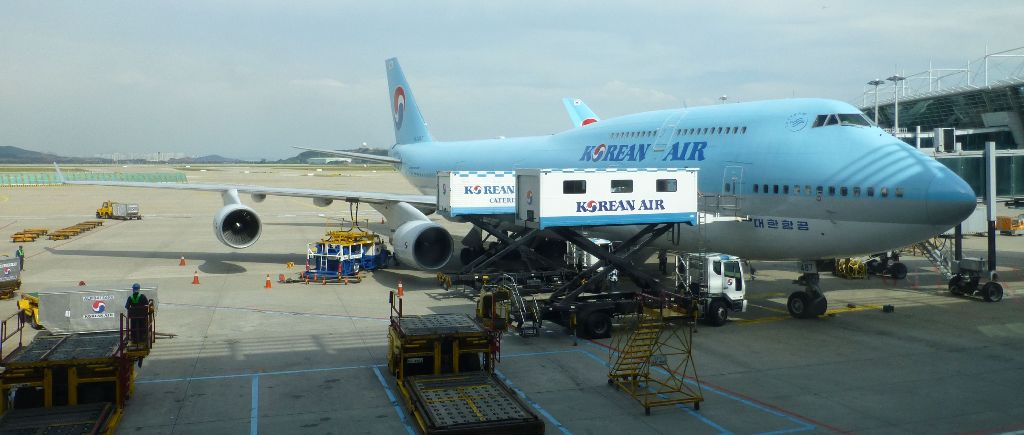
And A388

Even this small tank truck is in KE's corporate livery. I wonder how many round trips it made to top up the tanks of the plane which is behind it, guided by a KE Follow me car.
ICN's master plan is easy to understand: an arc with two protruding antennas, with a satellite terminal in front which accommodates the foreign airlines. Since I was connecting on two KE flights, I stayed in the main terminal which has mostly KE flights.

This terminal is wide and has ample sunlight, and very quiet since there are no PA flight announcements.
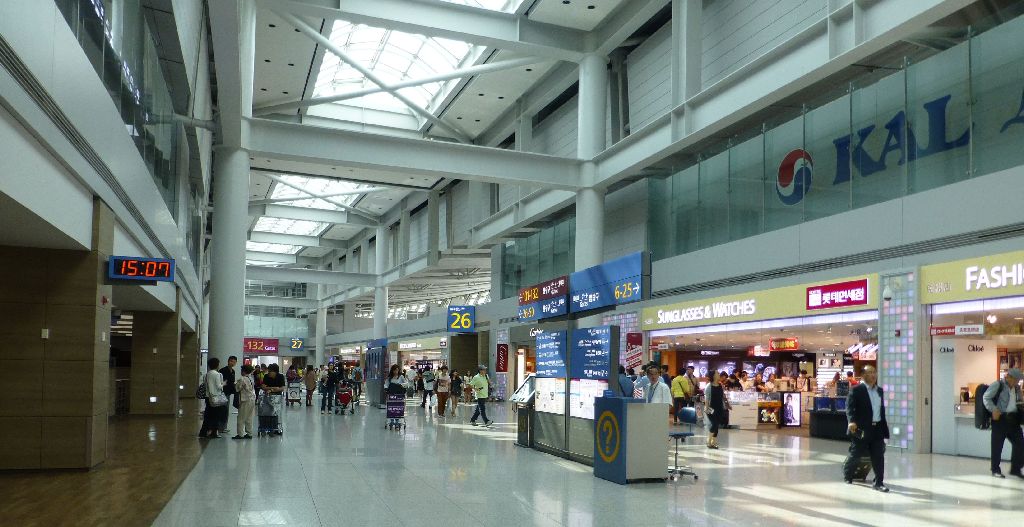
The information points are sufficiently numerous and well indicated not to have to look for them. That is where a probably retired volunteer told me where I could change my BP.
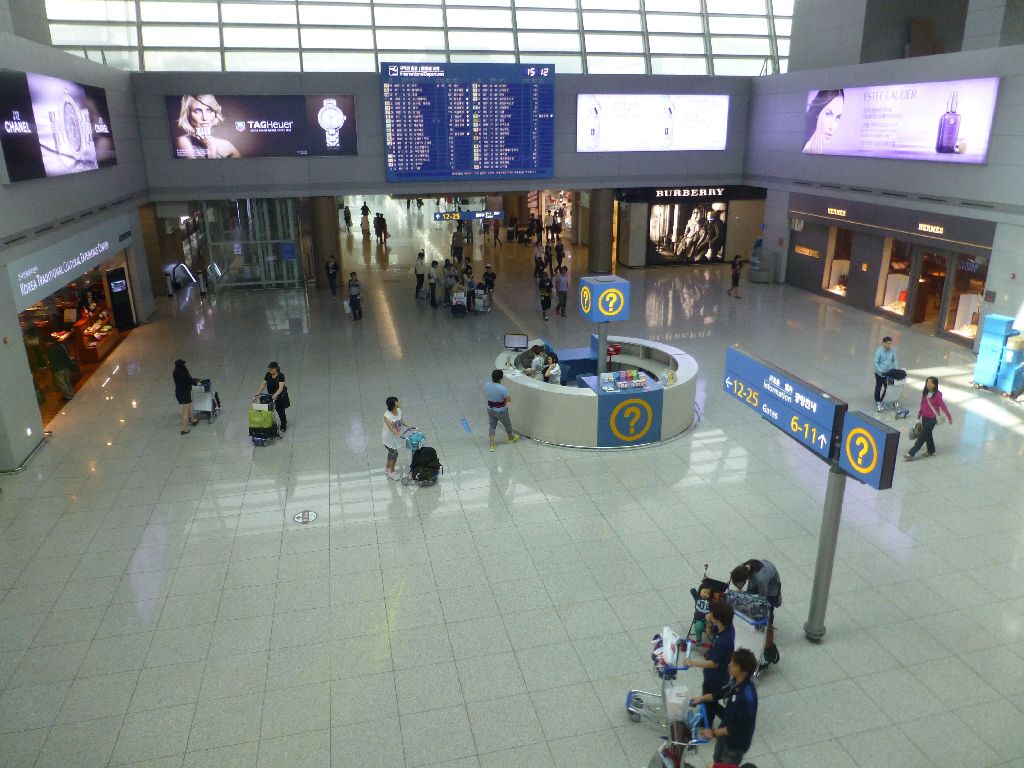
This is the KE counter where I asked to change for a window seat. See the size of the line:

The BP that I had obtained in CDG was for an aisle seat, and it was not possible change that seat in CDG. A window seat on the left? No problem, answered the friendly staff, who then gave countless excuses for finally having none available. OK for a window seat on the right (the lighting would be less favorable). I am used to single aisle aircrafts' window seats to be coded A and F, but this BP made it clear that seat 7E is indeed a window seat.

A display of leaflets on the various tourist trips which you can take if you have a minimum of five hours between flights. The prices are typically 20 USD (without a meal) and 50 USD (meal included)… and hundreds of USD if you want to have medical services. There is an impressive medical tourism offer for what I presume to be North American. I am also told that many Taiwanese go to Korea for better plastic surgery (and Mainland Chinese go to Taiwan for better plastic surgery).

Again in the upper level, the entrance of a non-airline lounge which can be used for a fee, and also comfortable sofas which are for anybody to use.
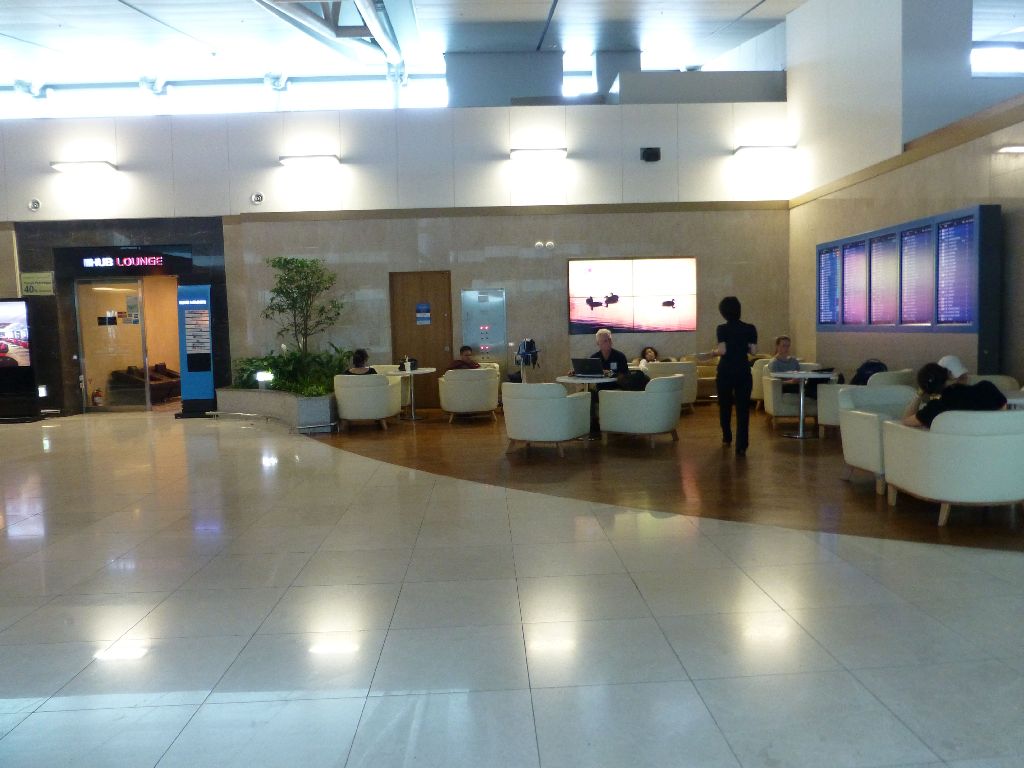
And just in front, a piano in automatic mode, with a trilingual sign stating where to ask to play that piano yourself.
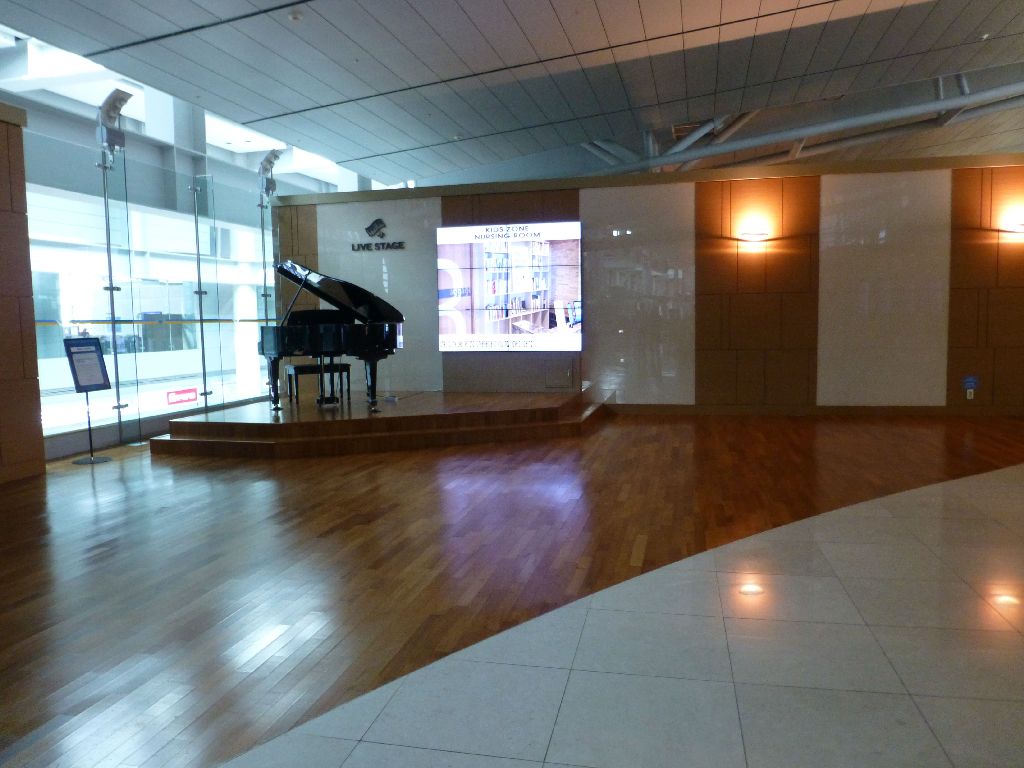
The access to the KE business lounge is not well indicated, but it was easy to ask to find.

The entrance of the KE lounge from the toilets area. KE communicates a lot on its A380s, with the small image wall in front of passengers arriving up the escalator.
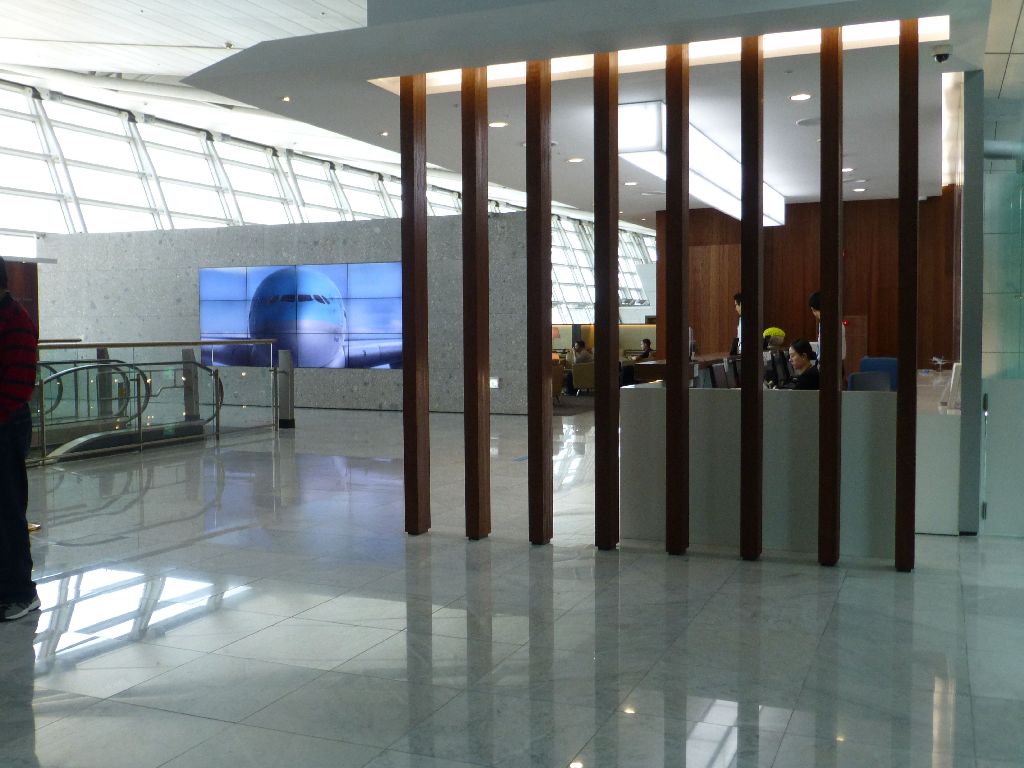
And symmetrically, in front of the destinations display.
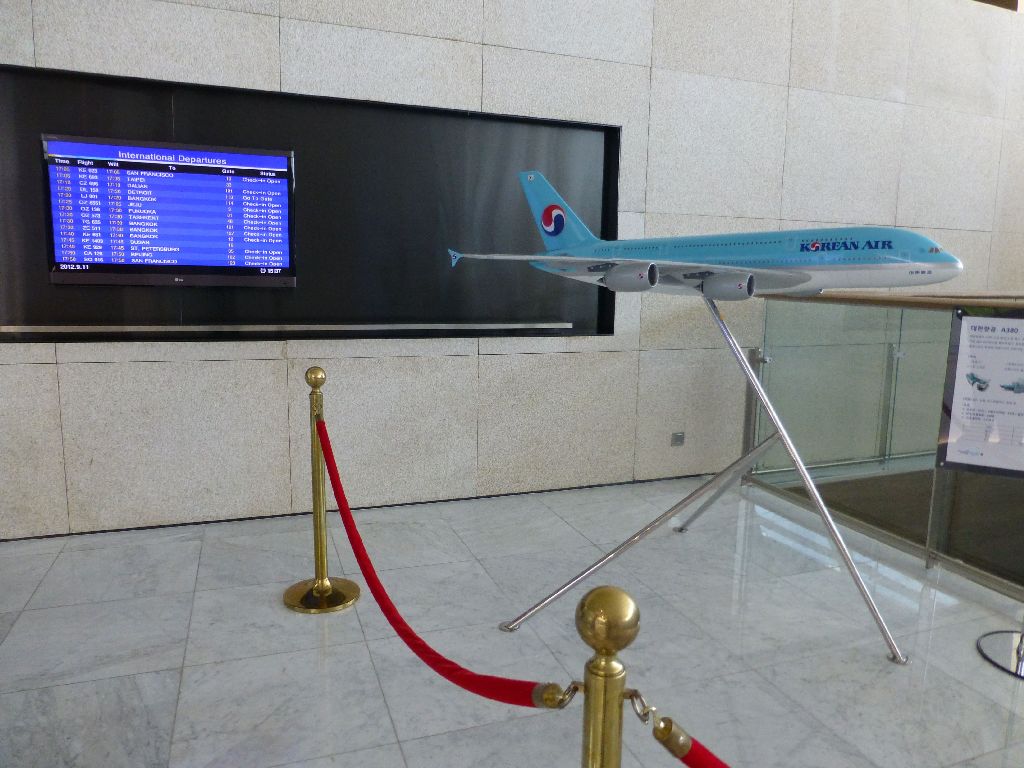
There was going to be a long line at BKK's immigration, with three simultaneous Korean planes leaving at 17:30 (no, this was not a sharecode, there were three very distinct boarding gates).
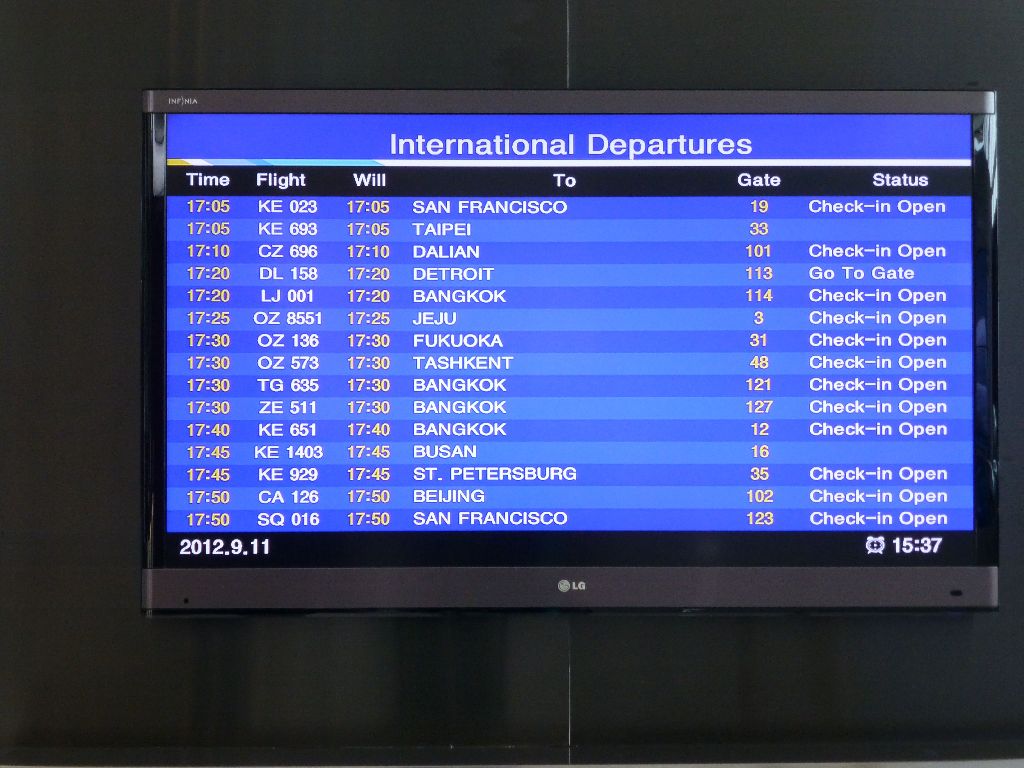
The lounge offers an excellent view on the space separating the terminal from its satellite and on runway 15L/33R on the right.

What is more, the counter in the background makes it possible to surf on the net using the free wifi access while looking at the view.
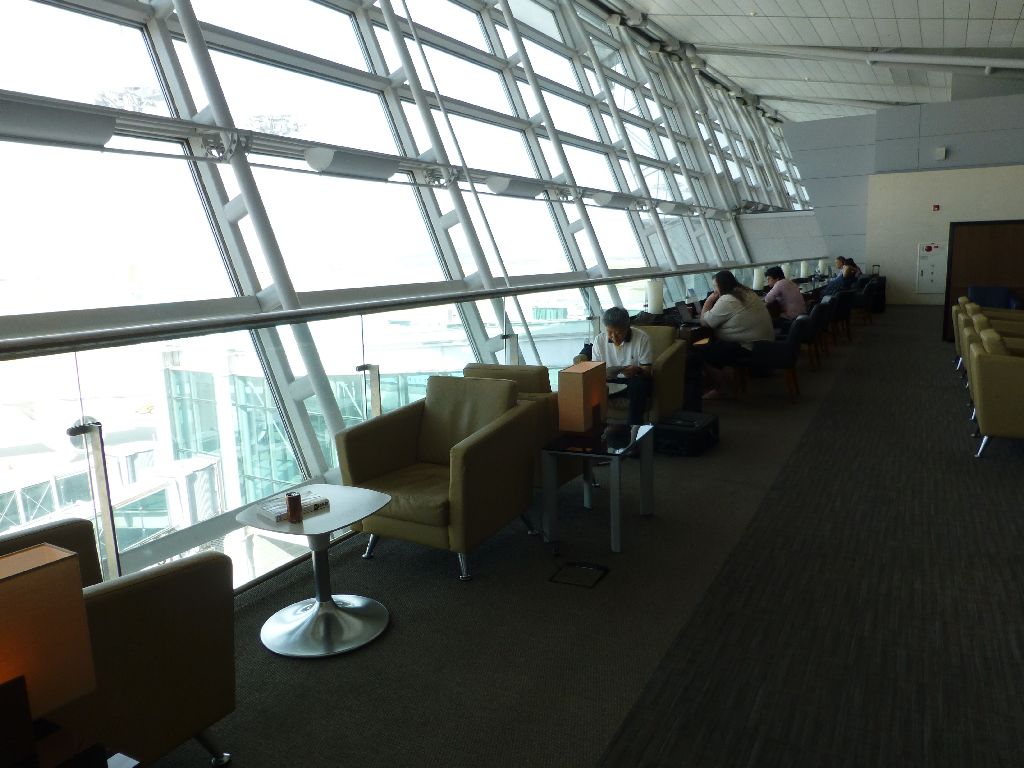
A delicate lighting compromise to have the corporate screenshot with a KE aircraft in the background
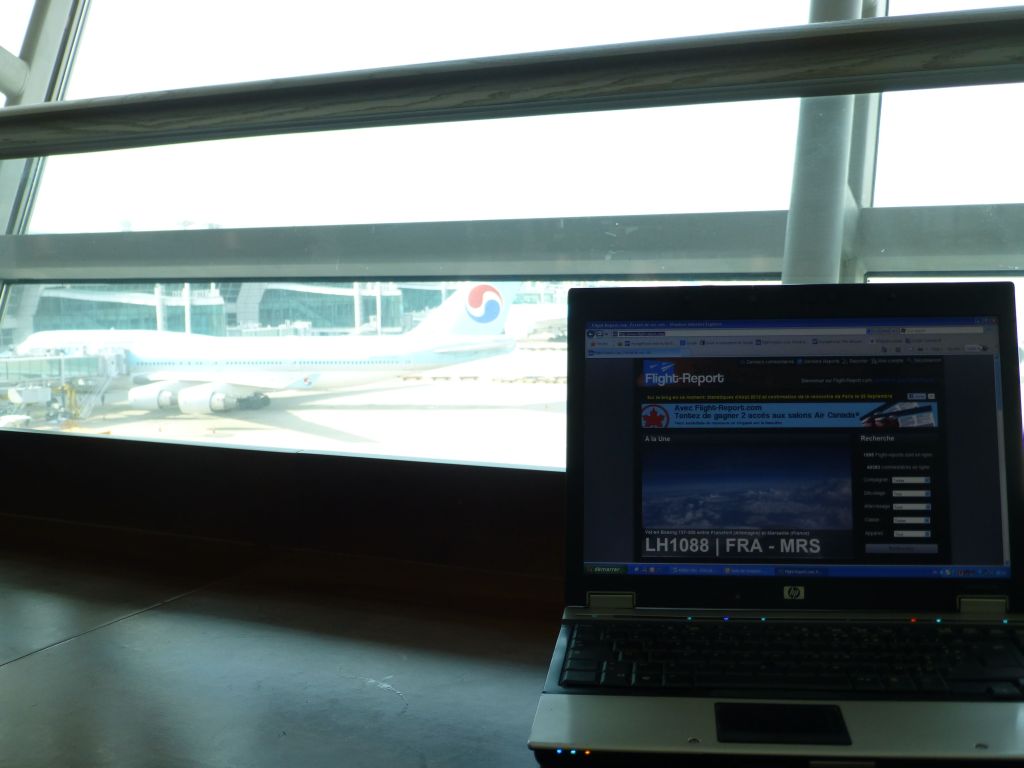
This is the most formally forbidden to men baby care room that I ever saw.

Do not despair though: the toilets and showers are reasonably accessible to both sexes, since each cubicle is independent from the others.
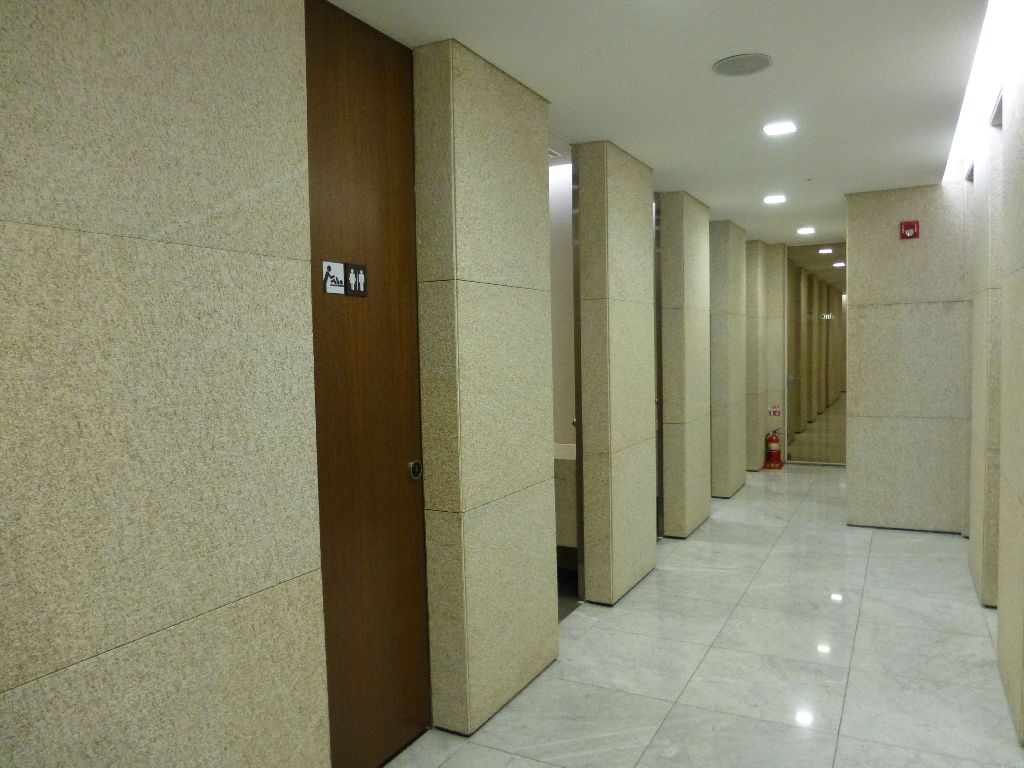
There is a reasonably neutral pictogram in front of a baby.
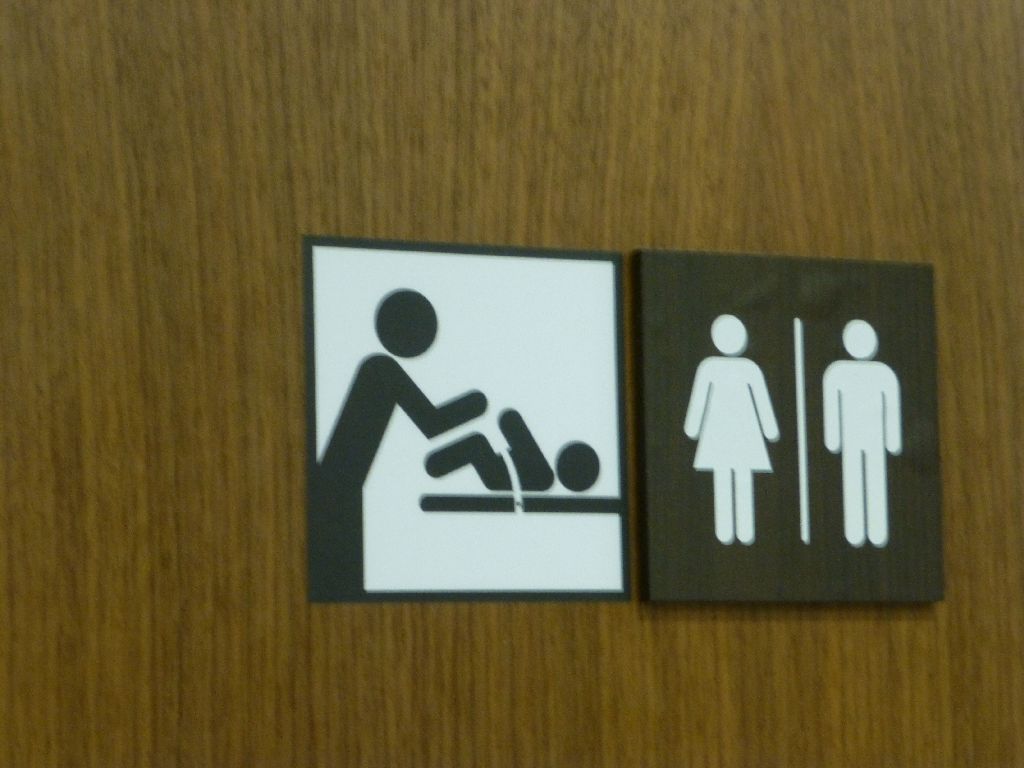
The toilets are identical to the ones as in Japan, apart from the control panel which is all in Korean, with a Post It note for illiterate passengers who cannot read the hangul alphabet.

I did not test the Senior button: for marathon runners, the Senior category means 21-39 years old which I left some years ago.
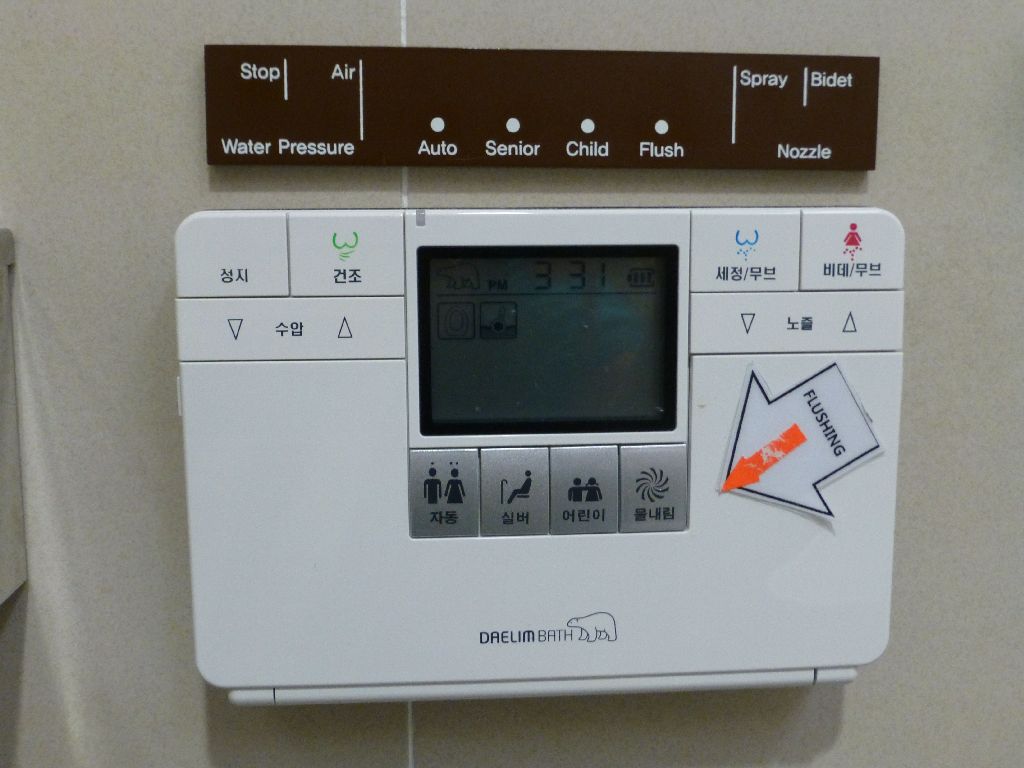
After satisfactorily using the Illiterate button, I went to get some food.
The buffet has sharply sober aesthetics, but the offering is really poor. From the geographic proximity, I had expected some sushi, but I was forgetting that the Korean took a dim view of the Japanese actions in the first half of last century. The four hot meals were not very attractive, sea food noodles looked like the least bad option.
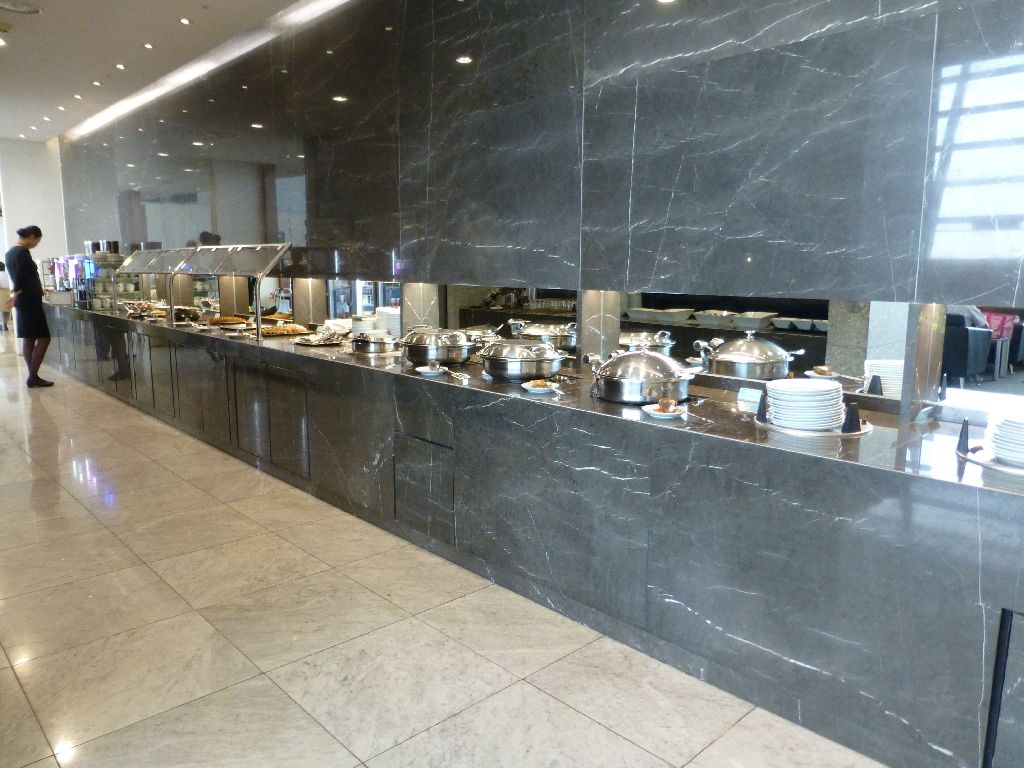
There was an ample supply of non-alcoholic and lightly alcoholic drinks
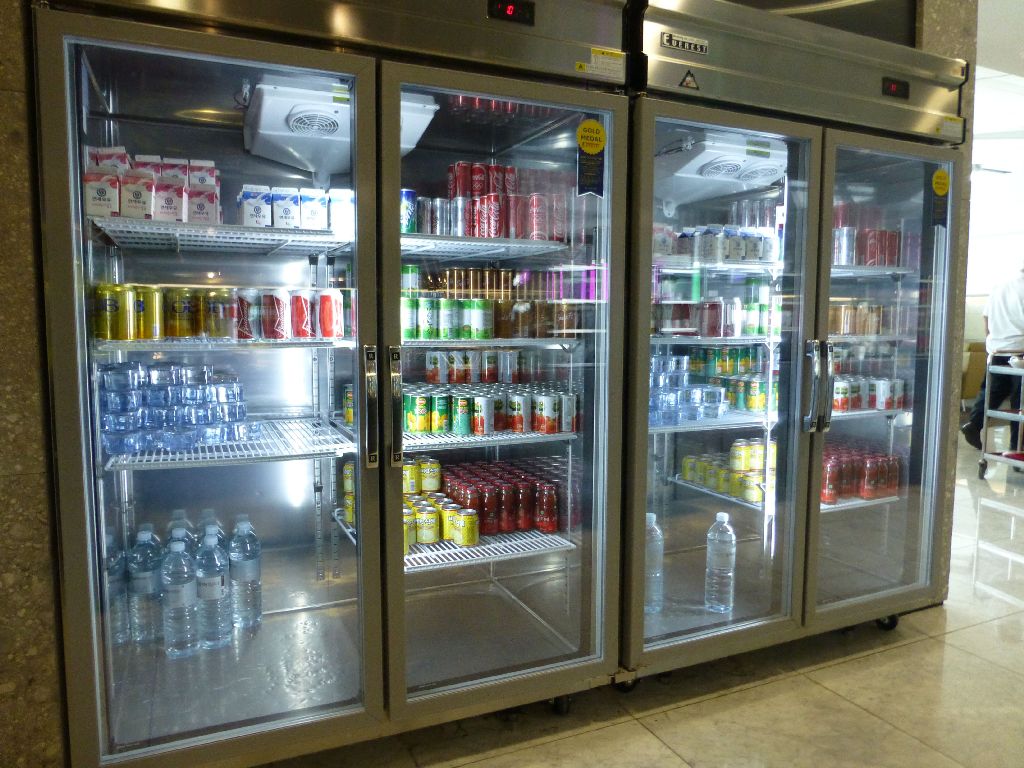
And a very limited choice of more alcoholic drinks: exactly five bottles, including two of wine.
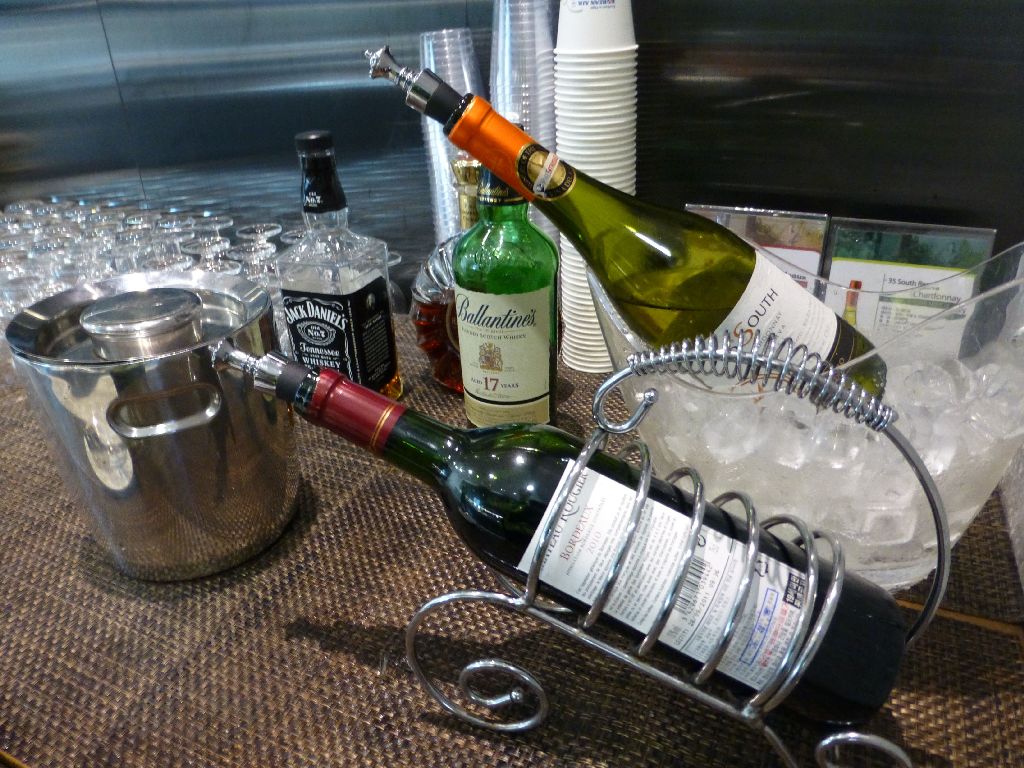
If you prefer Asian junk food, there are instant noodles in the back, beyond the coffee machines.

The ensuing section of this report is dedicated to all the Flight Report newbies who find plane spotting difficult. Even when you are in an uncrowded plane spotting friendly lounge with a bright blue sky, you can miss a large number of opportunities.
The few supports of the huge windows have a real talent for moving like the goal keeper between you and the target.
This is a typical miss.

Another example of the spectacular window frame moving in front of the Air Bishkek the only time it was correctly focused.

I was trying to have an unusual picture of the rear of a TG 772, but when I managed to have its tail in the pictures frame on the left, it quickly put its landing gear out of it on the right.

And when I take advantage of this TG 772 leaving the place, the tail of a KE 77W steps in to hide the wingtip.
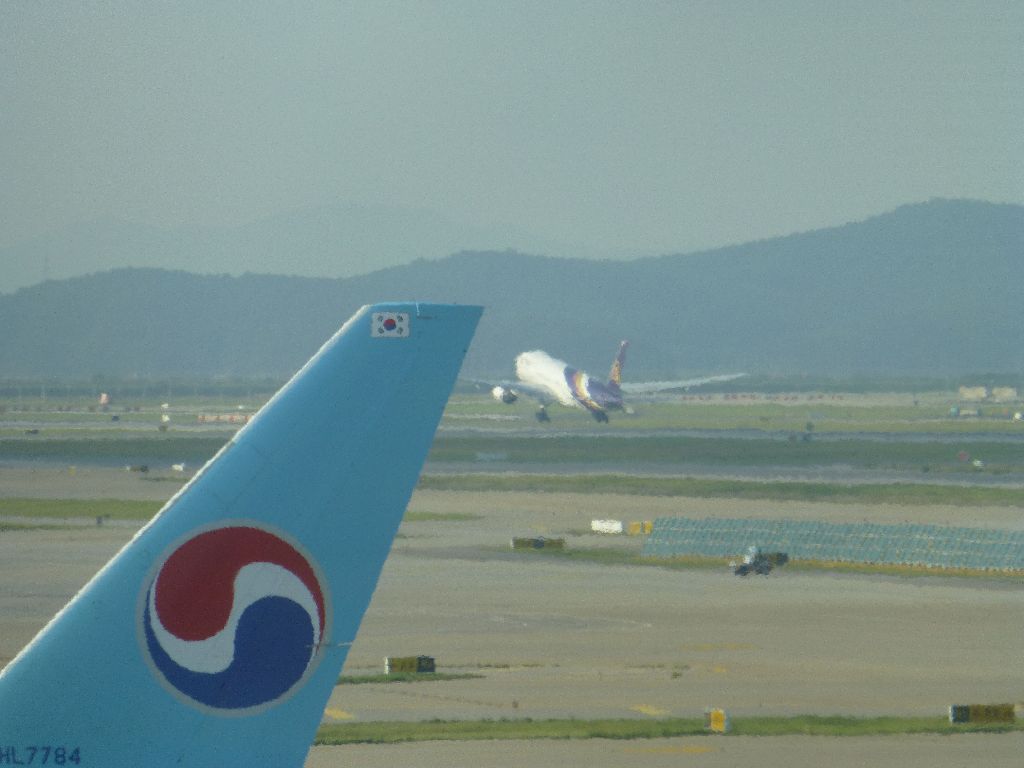
This Aeromexico plane in Skyteam livery hid itself behind the satellite terminal before I could take a correct picture.
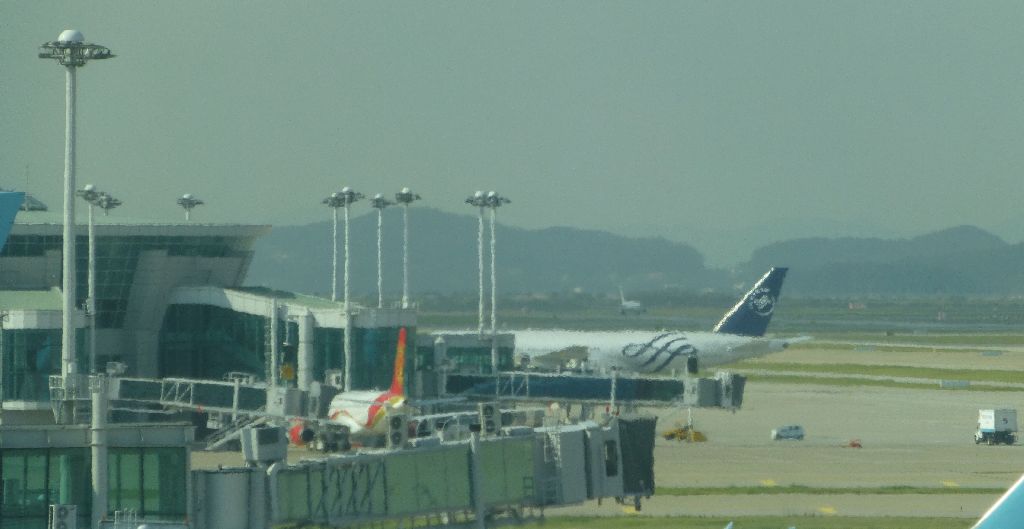
On a bright sunny summer day, the air is hot, especially when you burn kerosene. The result is that the pictures are badly pixellised. Especially those of the rare Air Bishkek plane.

After this long series of failures, let's turn to a long series of KE aircraft, starting with the biggest in the fleet.
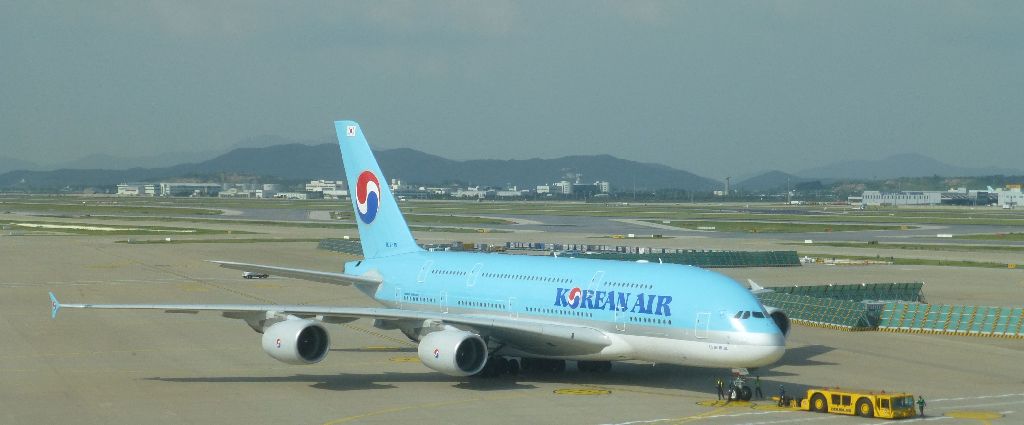
A B777 looks small when it follows a 388
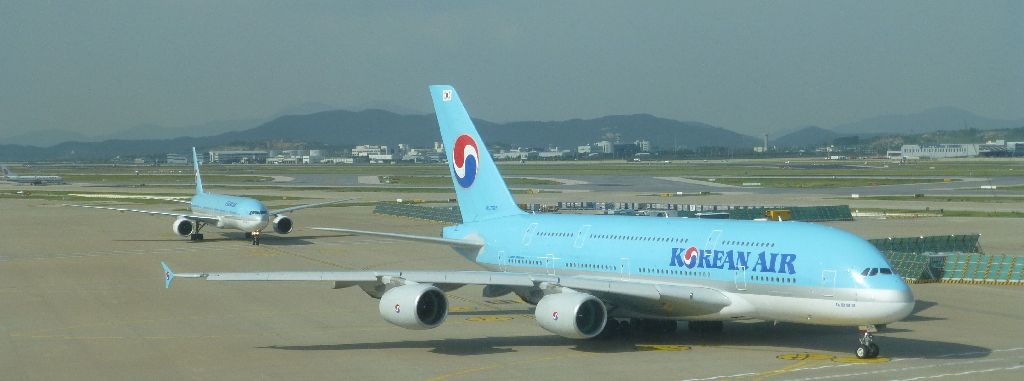
B773
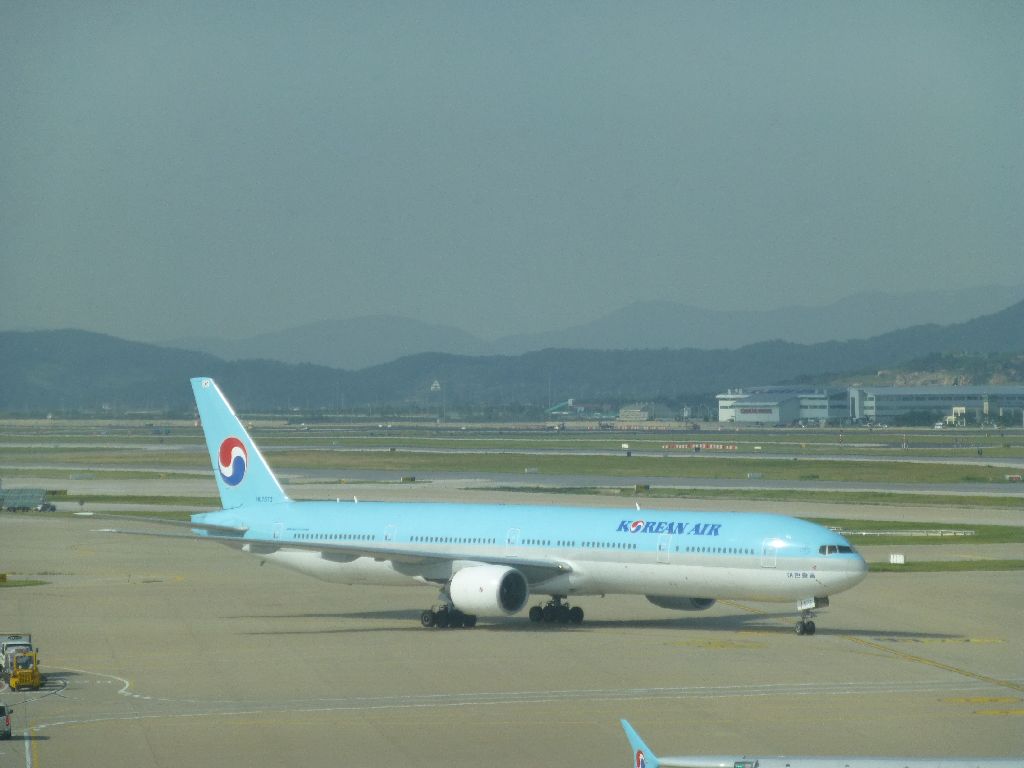
B773ER
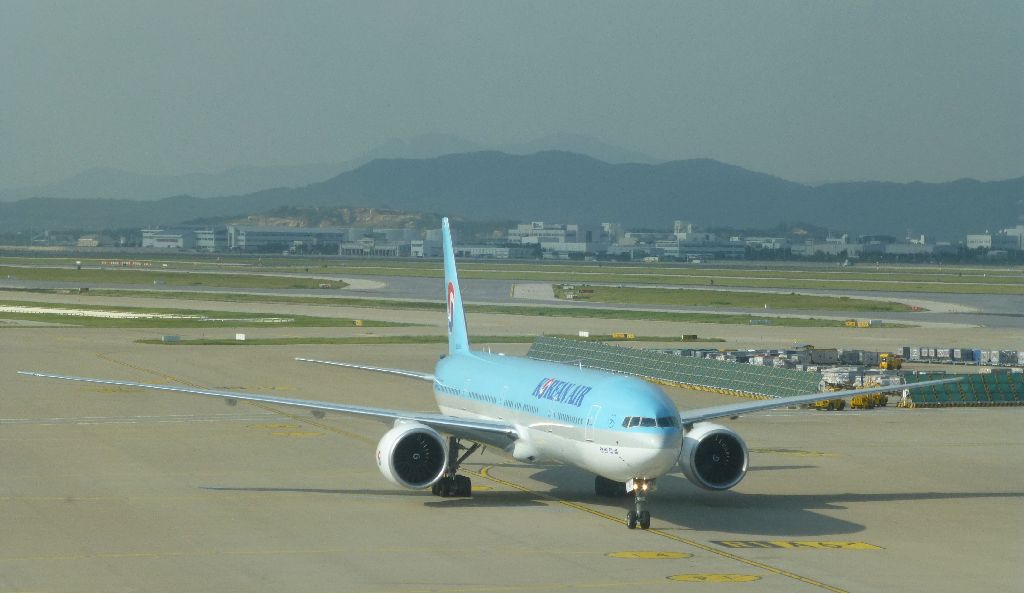
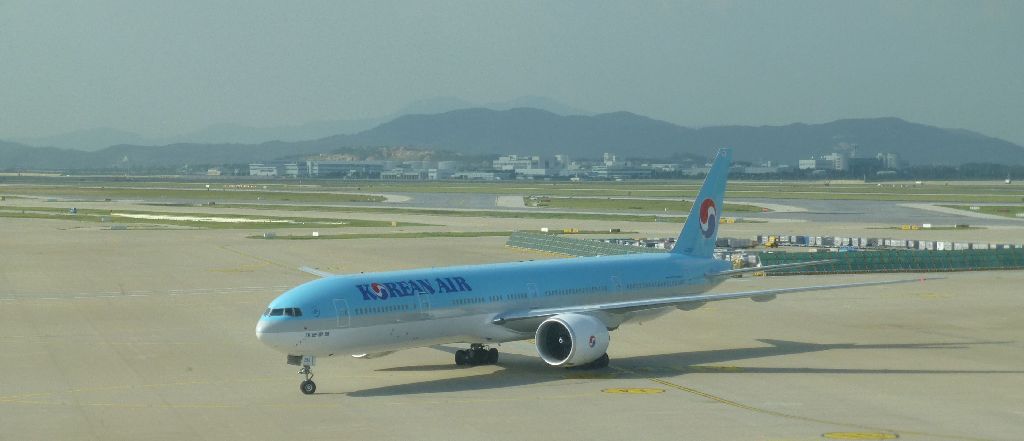
Several 744 from different angles


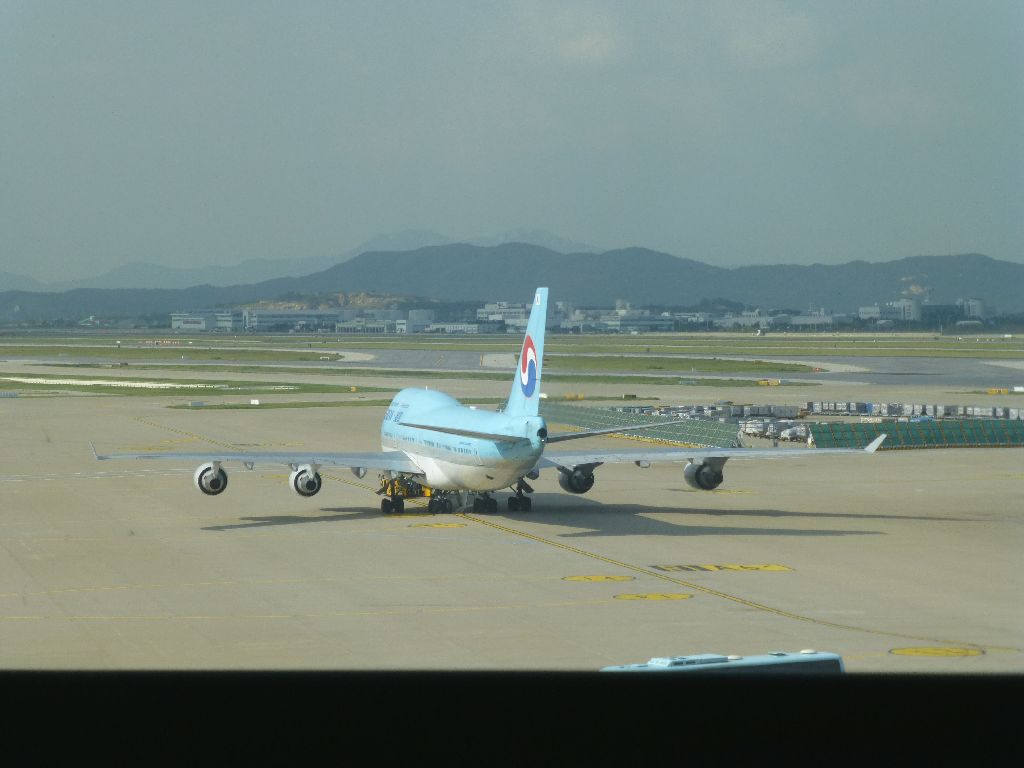
A rare item: there were only 52 B739s in operation at the time of that trip. Its identifying feature is that it is difficult to tell from a B738. In the background, the even rarer Air Bishkek plane - there were only two in the world.


It was not that difficult to identify this one.
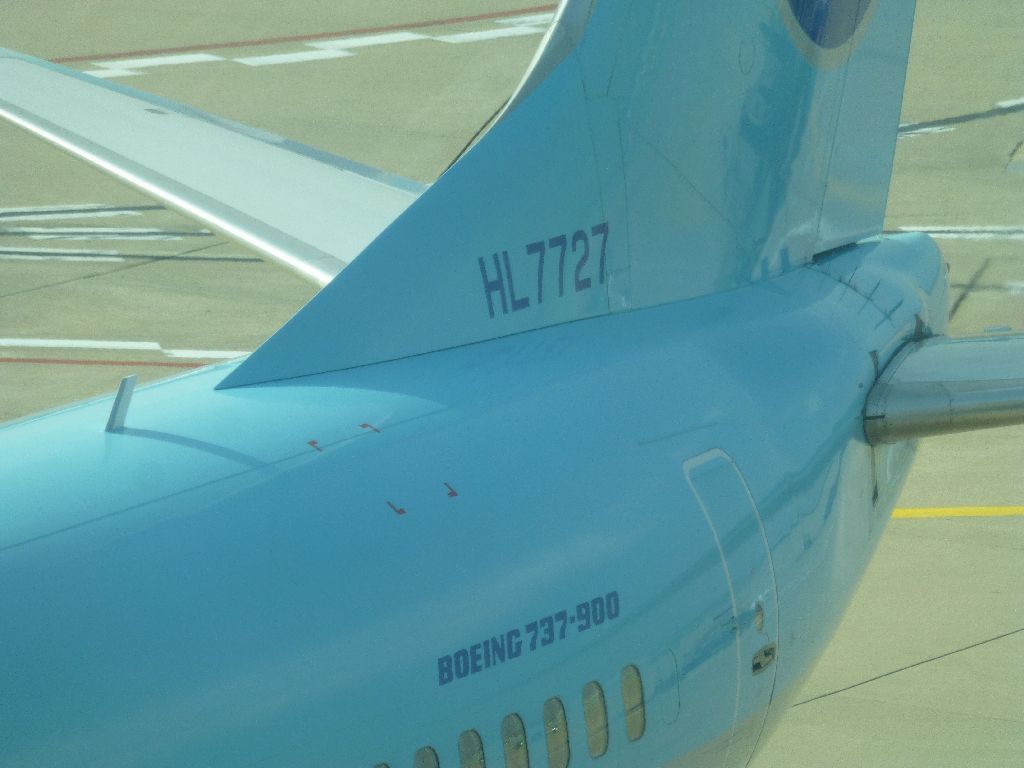
The lounge provides a view on the central part of one runway; since the weather was as beautiful that day as it had been disastrous on the way, but take advantage of it. Of course, a camera weighing several kilos would have been better, but I only have a compact one.
KE 744
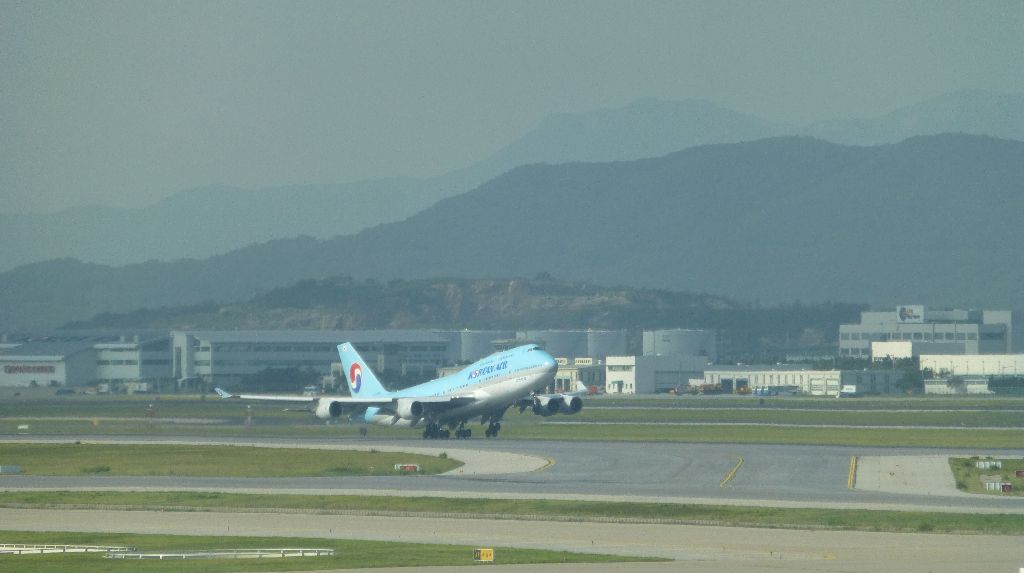

And 777

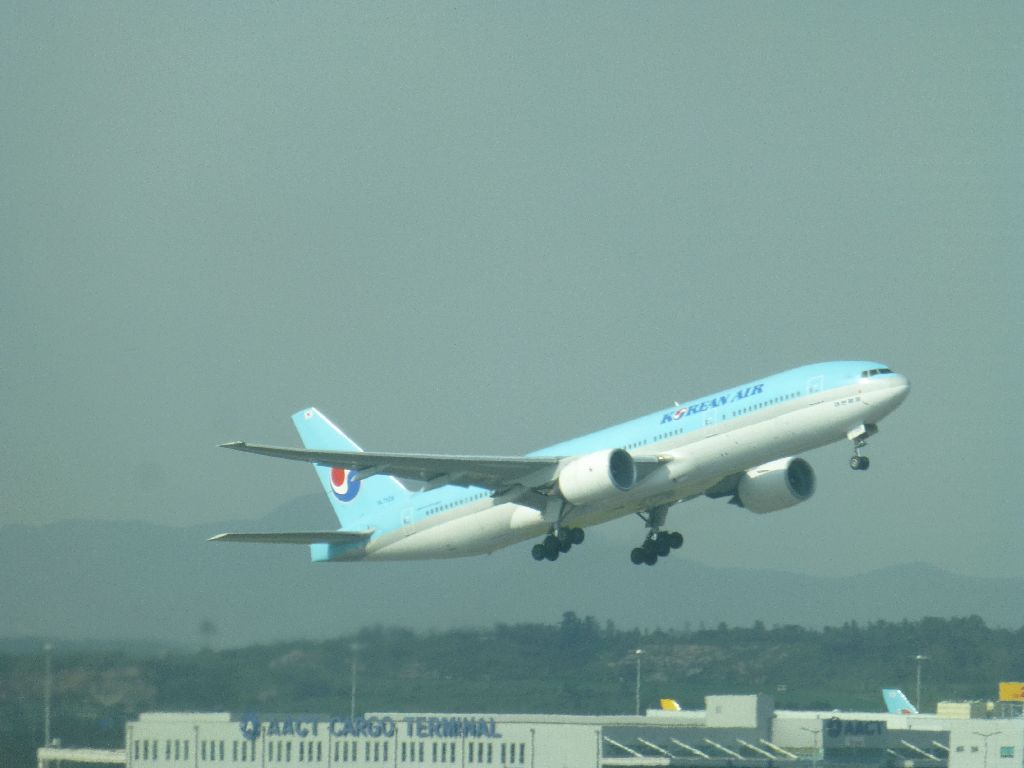
The cargo area is separated in two halves operated by Asiana on the left and Korean Air on the right.

No matter the airline, the 747s rule the cargo activity. KE 747 with deployed and retracted thrust inverters:
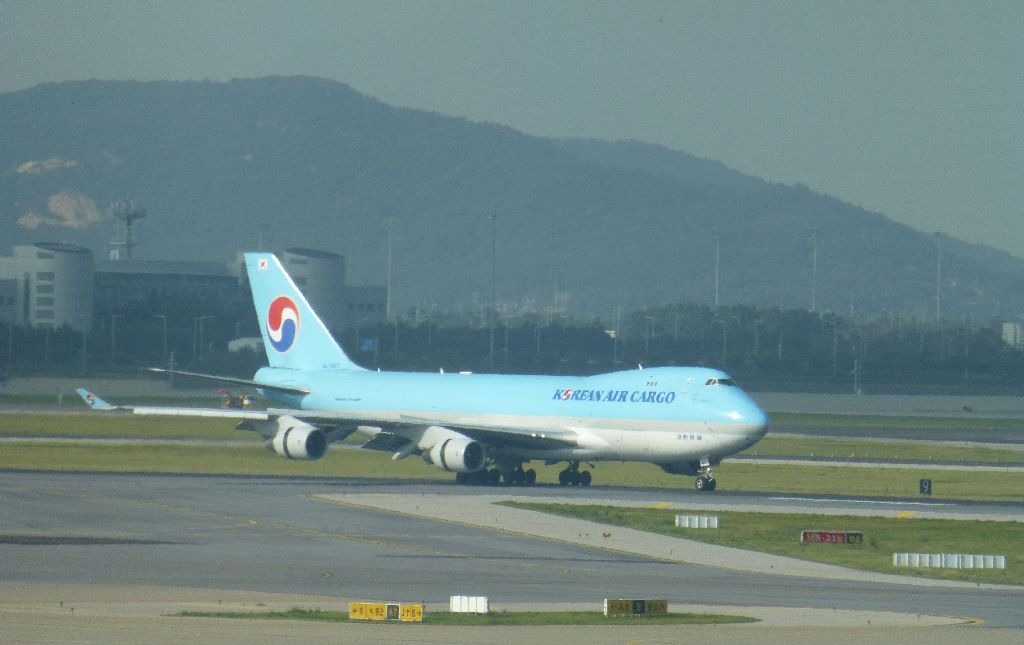
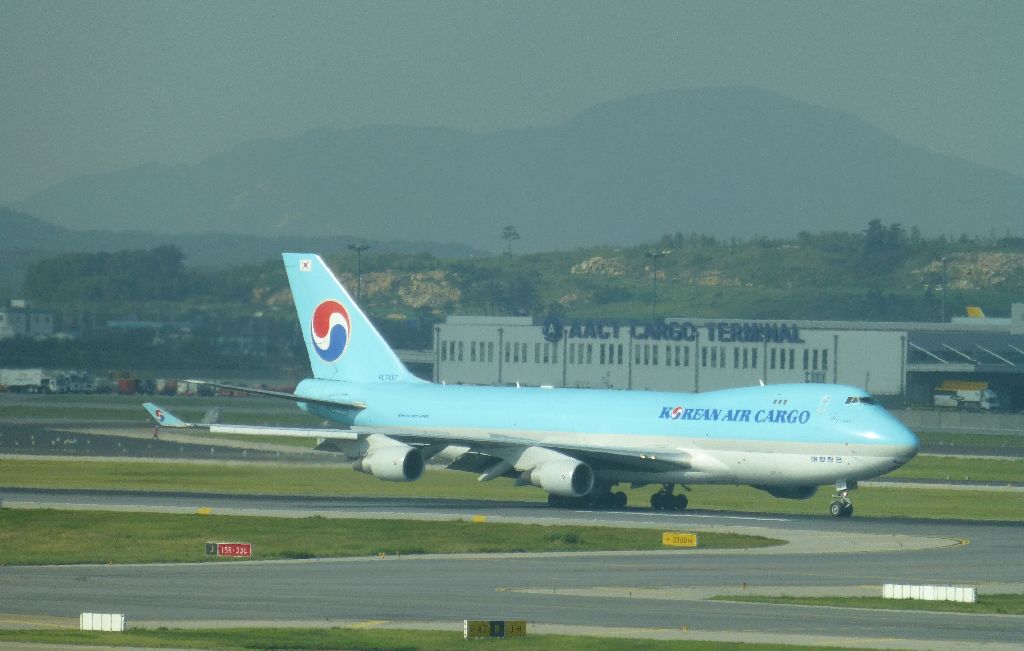
And the same belonging to OZ
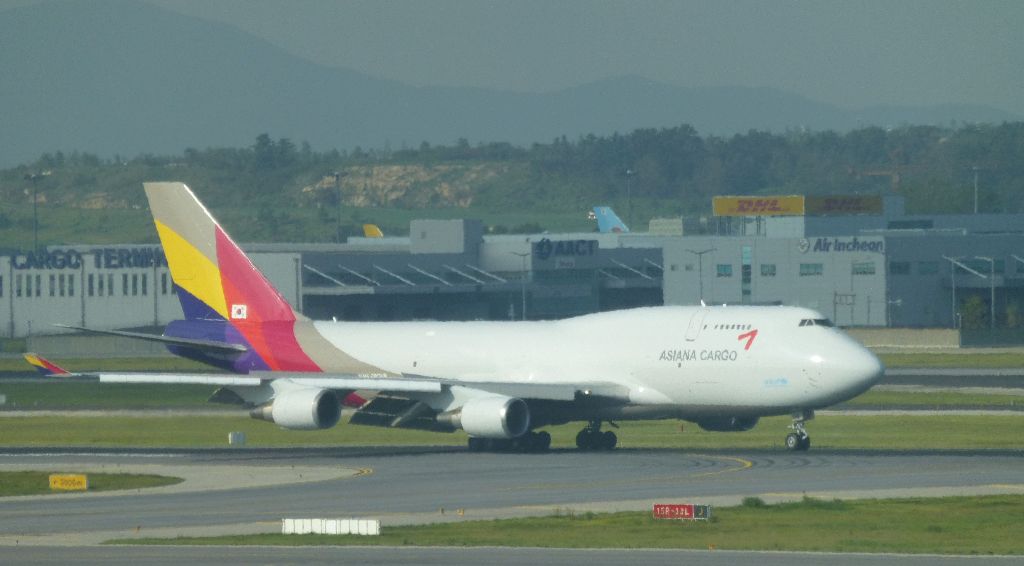
An intruder (Southern Air)

An aircraft in the old OZ livery on the right
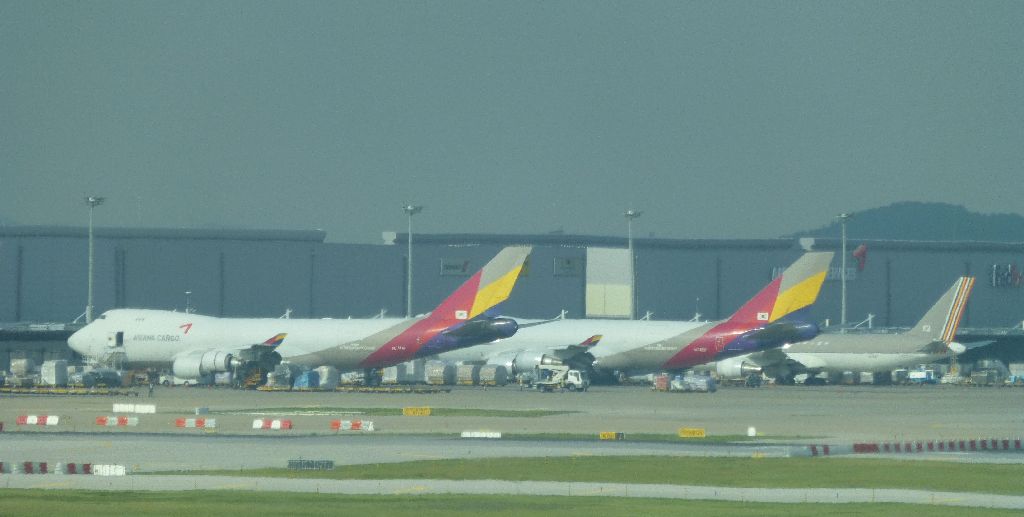
Asiana does not have cargo planes only. This is an A320
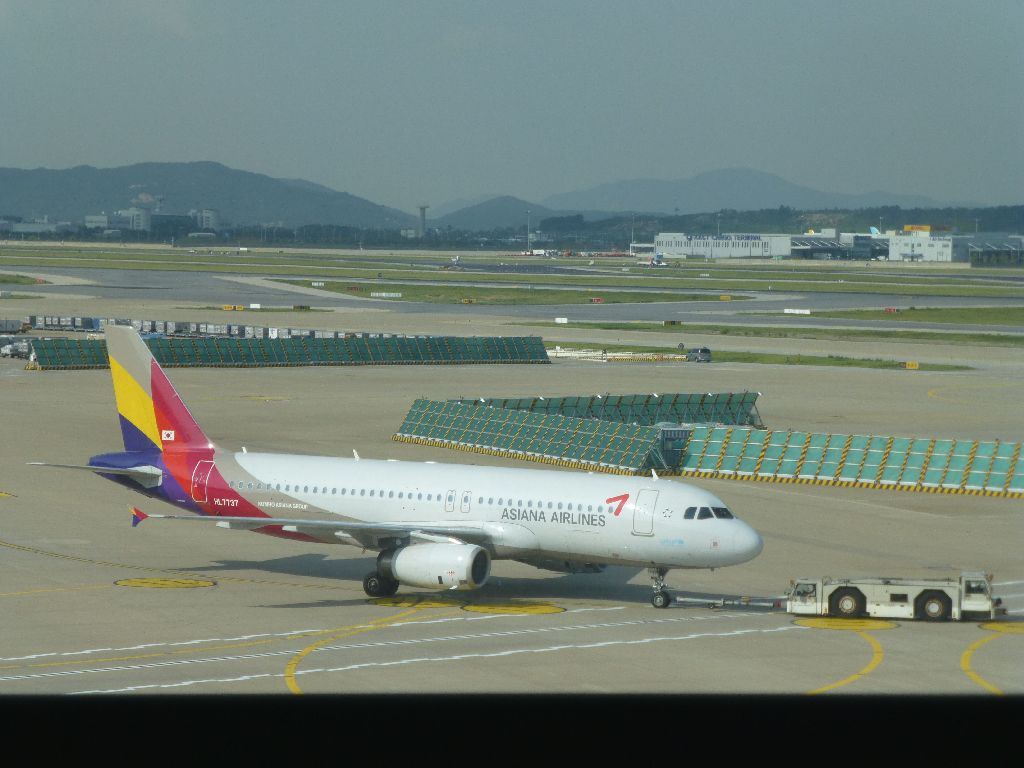
… and an A321
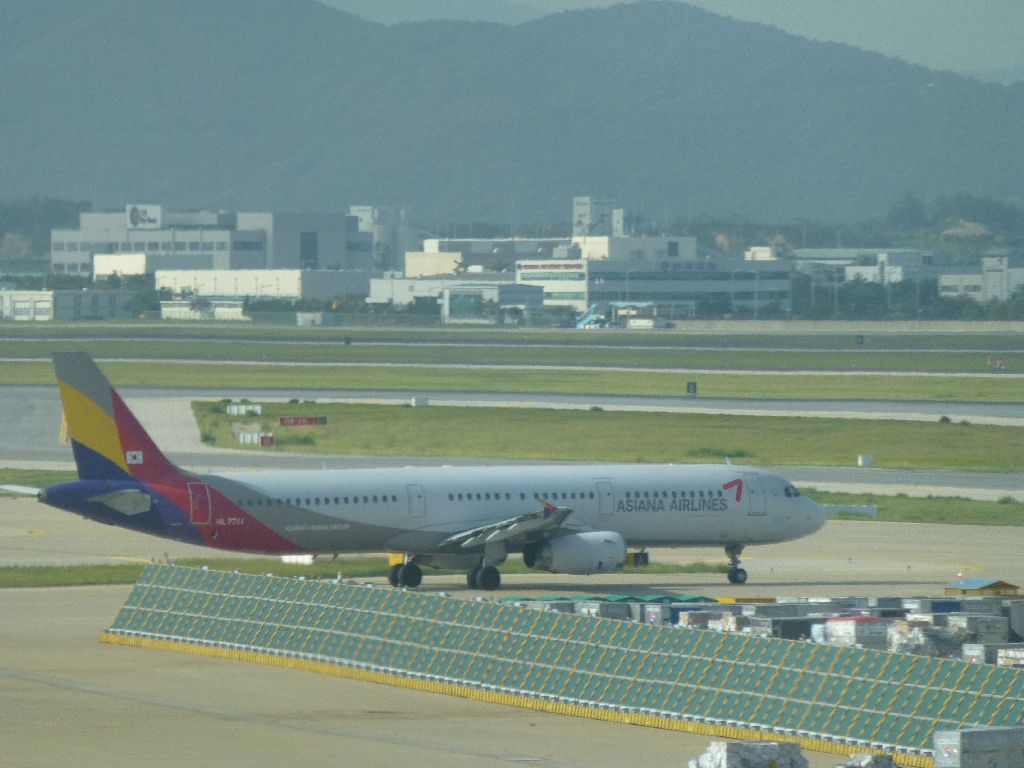
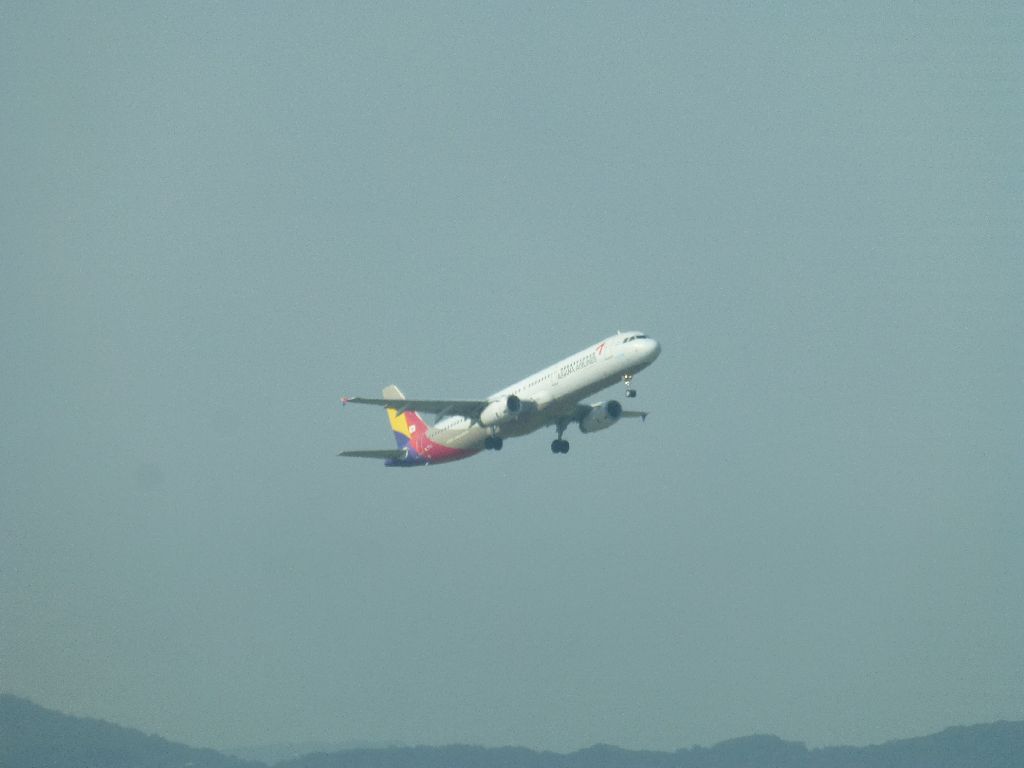
A330
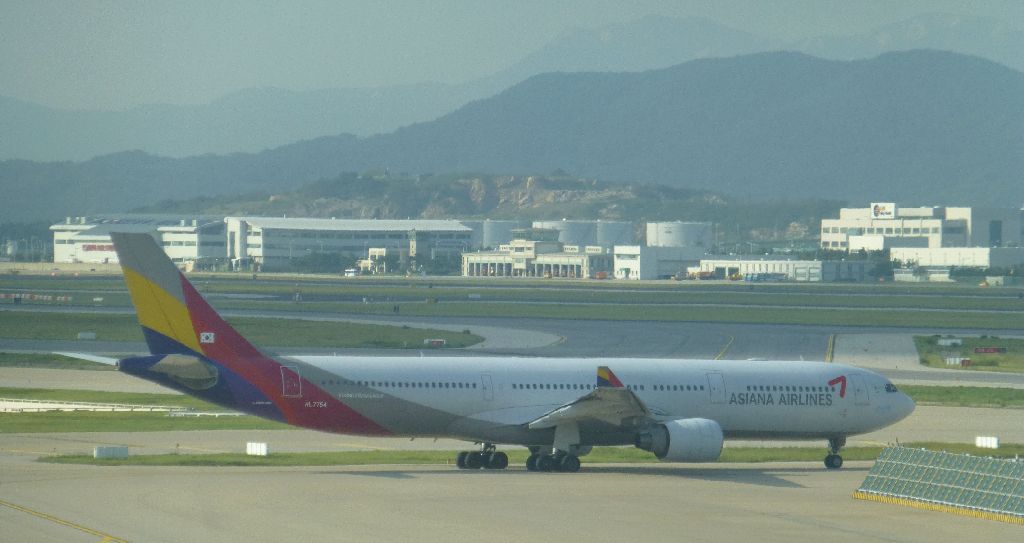

A difficult riddle: what is the corporate color of Peach Aviation, a Japanese low cost airline ?

Even more difficult: what is the type of this business jet? (I do not have the answer)
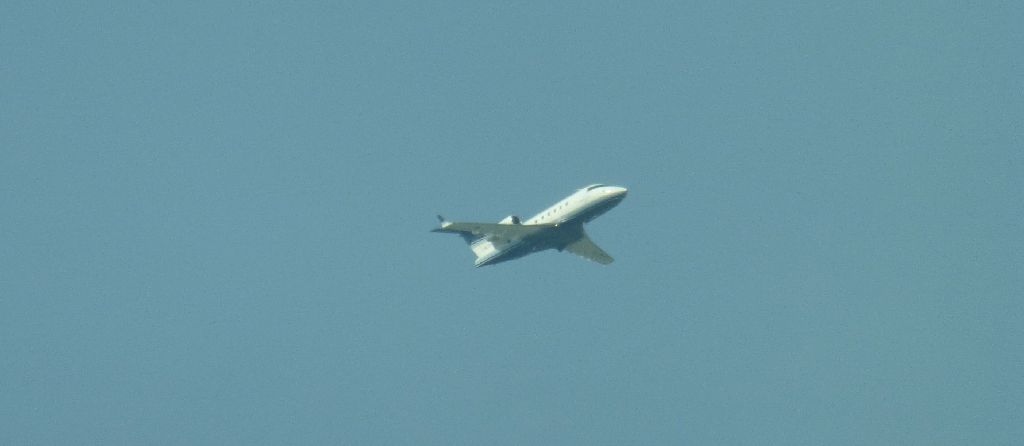
I do not take much risk in guessing that this one is a CA 738

With regards to the Peach Aviation A320, it was not very difficult
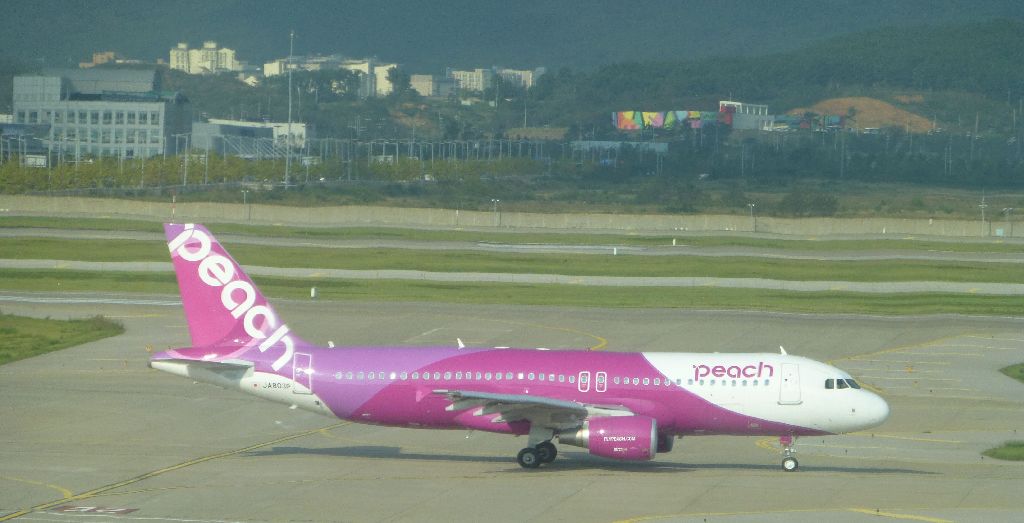
Take off
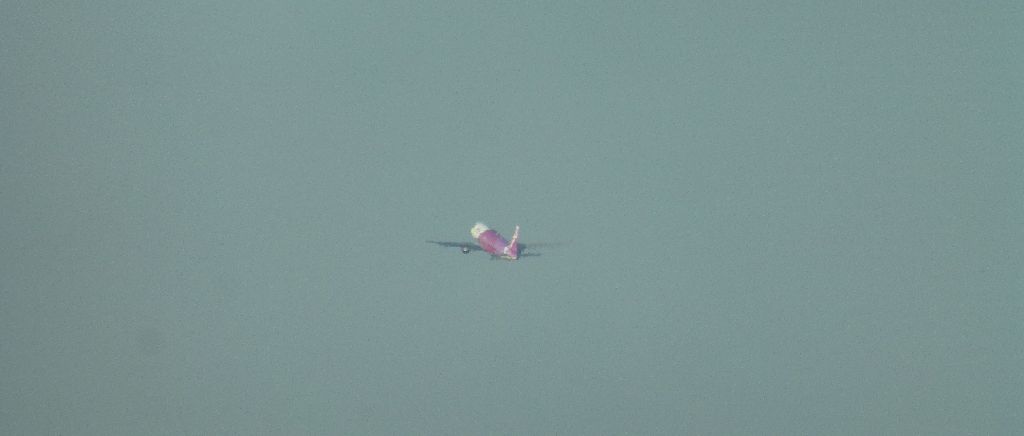
Did you notice something in the preceding picture? Yes, the wind direction changed, and Runway 33R is now in operation, as demonstrated by the landing of this 739 without winglets.
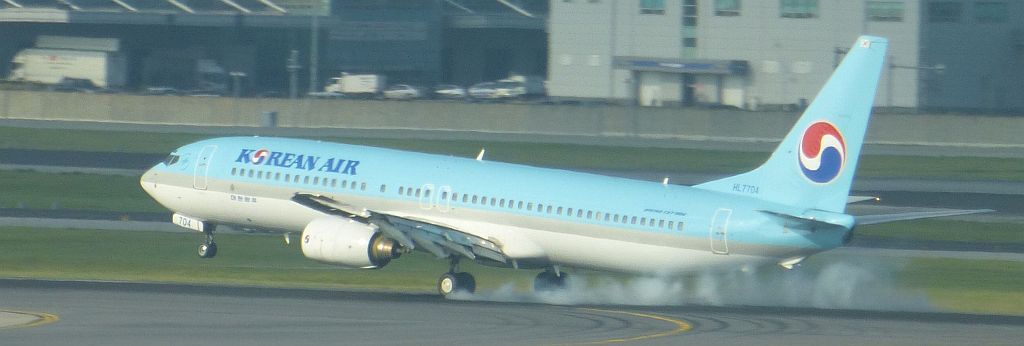
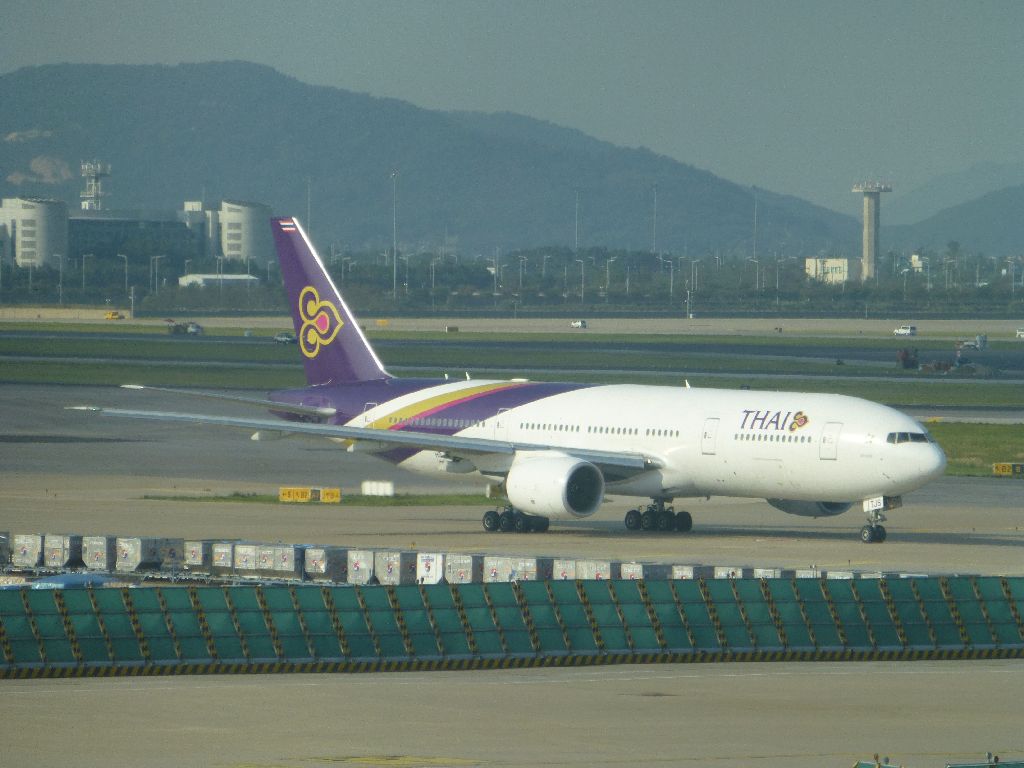
ZH 738

A Dali soft watches version of the same, due to the windows' distortions
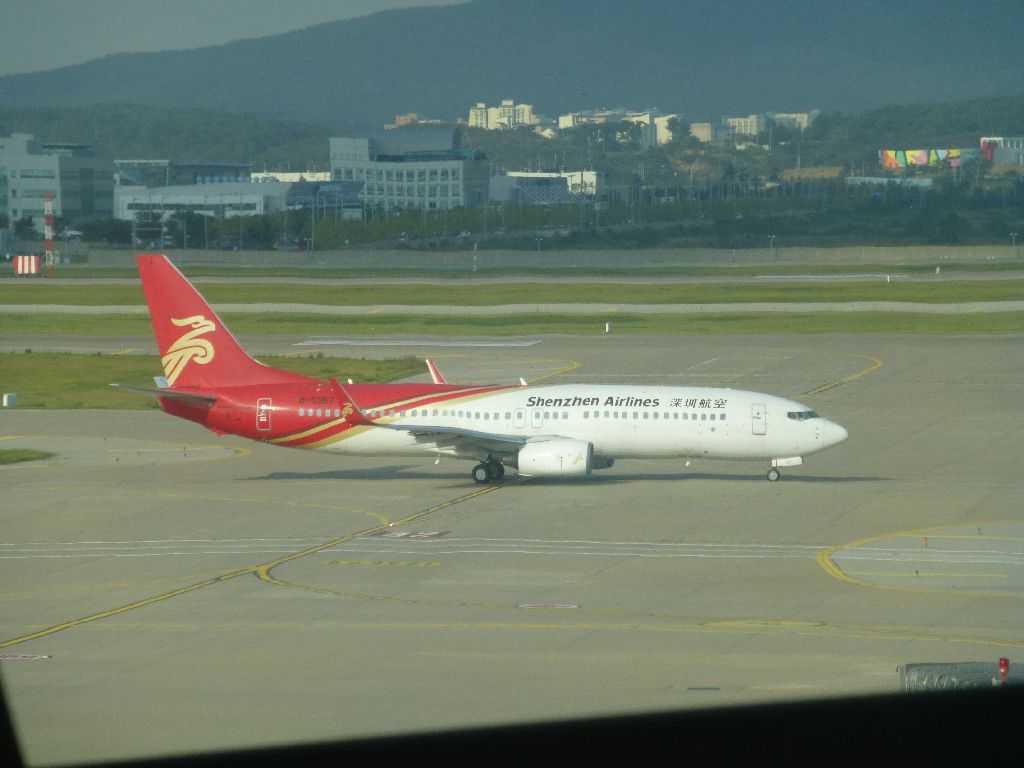
MU A321
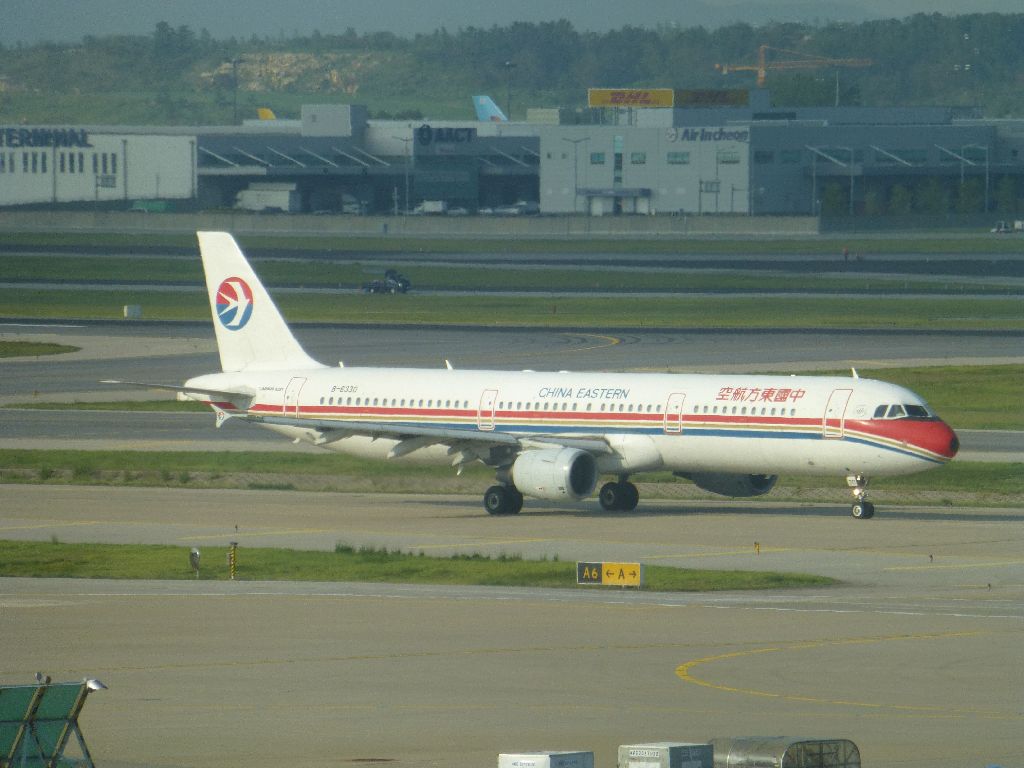
I had seriously underestimated the time needed to reach Gate 33 from KE's lounge, or more precisely, I left this extremely spotter friendly lounge at the last moment. I therefore have no neatly framed picture of my plane, which I reached when a staff was asking around Taibei? (this is how you pronounce is in Mandarin), with a tone of somebody who worries about having to unload the luggage of no-shows. Two young girls saved my face by arriving behind me.
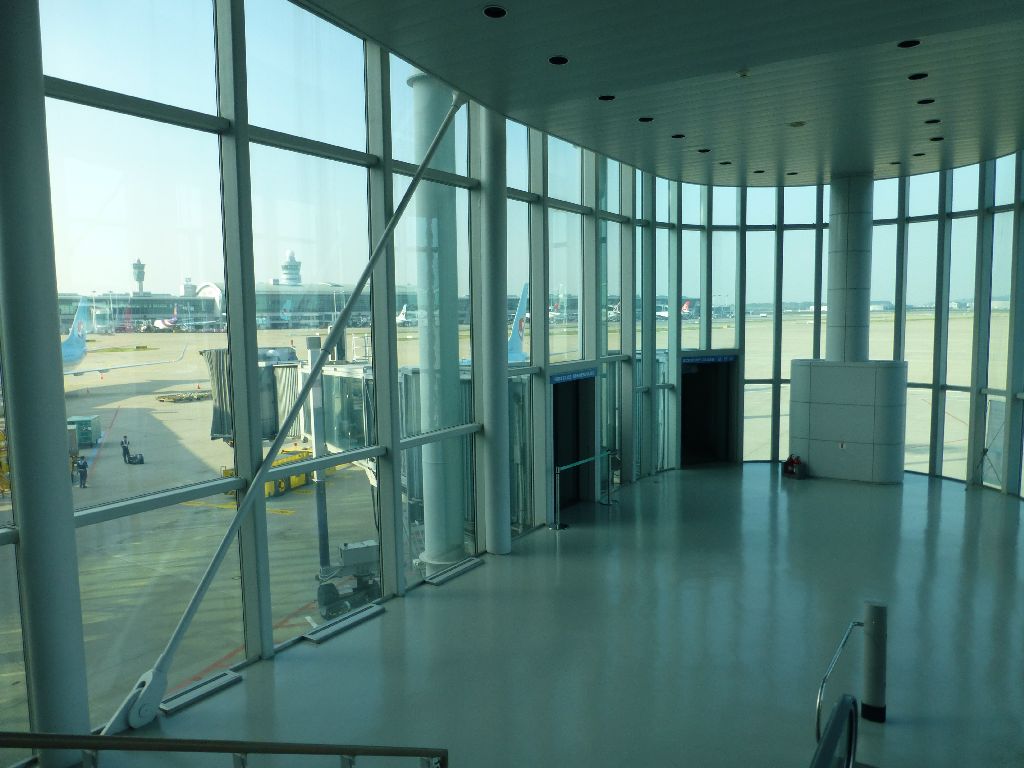
These are two pictures taken while walking down the jet bridge.
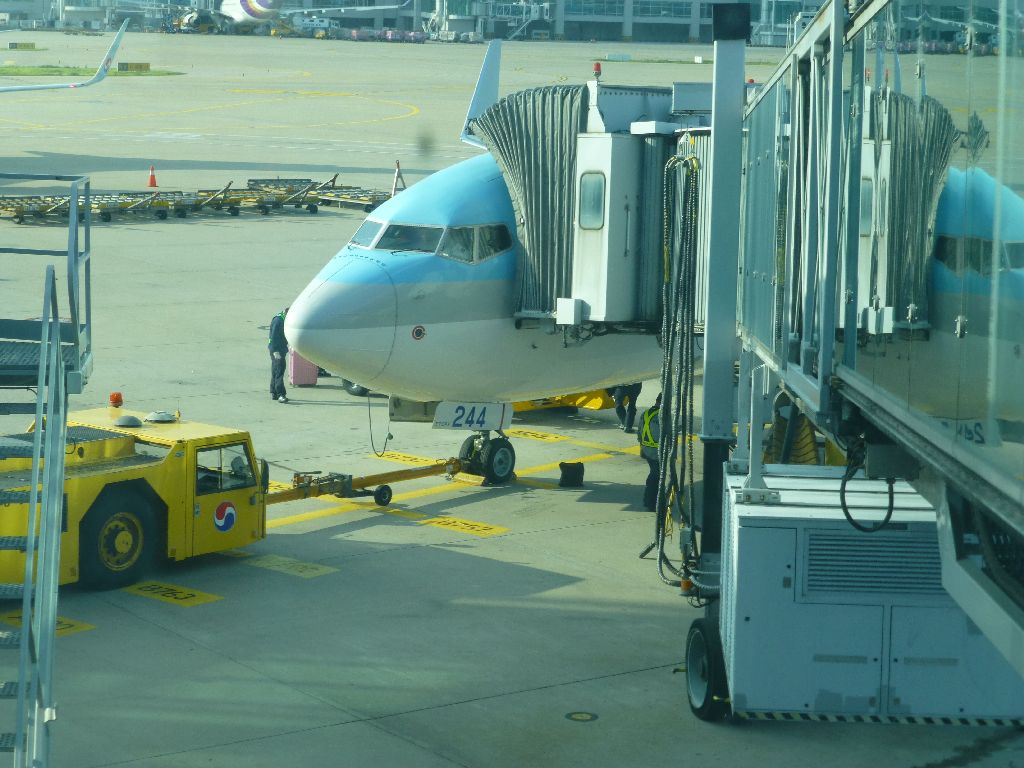
This set of three stickers has not changed in the past twenty years. Many of my colleagues used to stick one of them on their office doors.
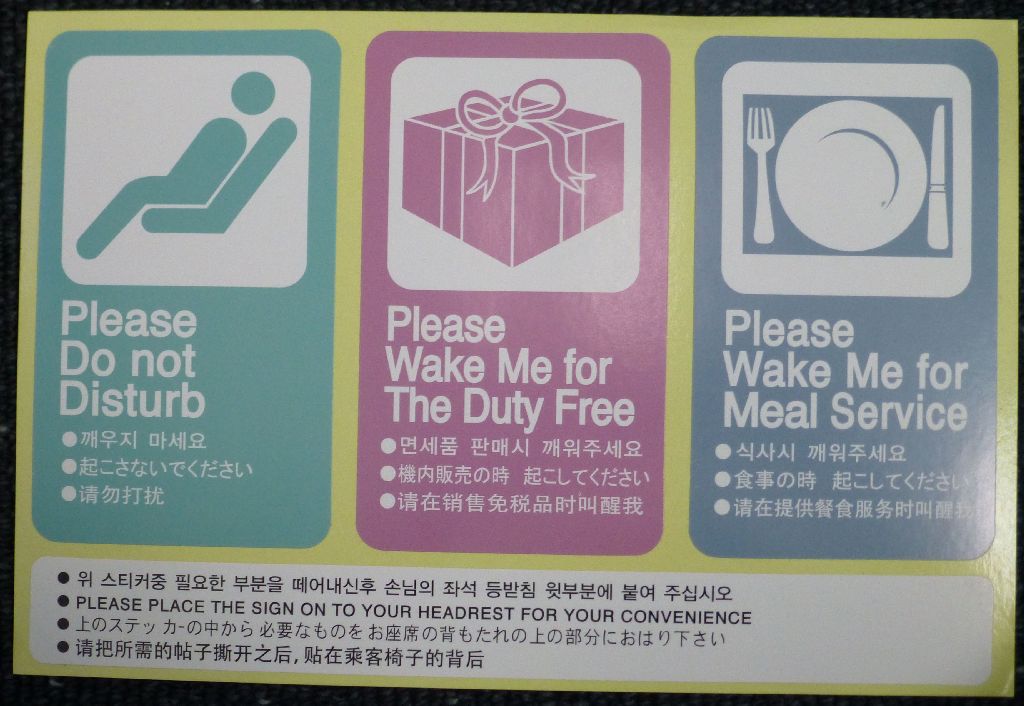
This is the J cabin when I left it : three rows in 2+2 layout
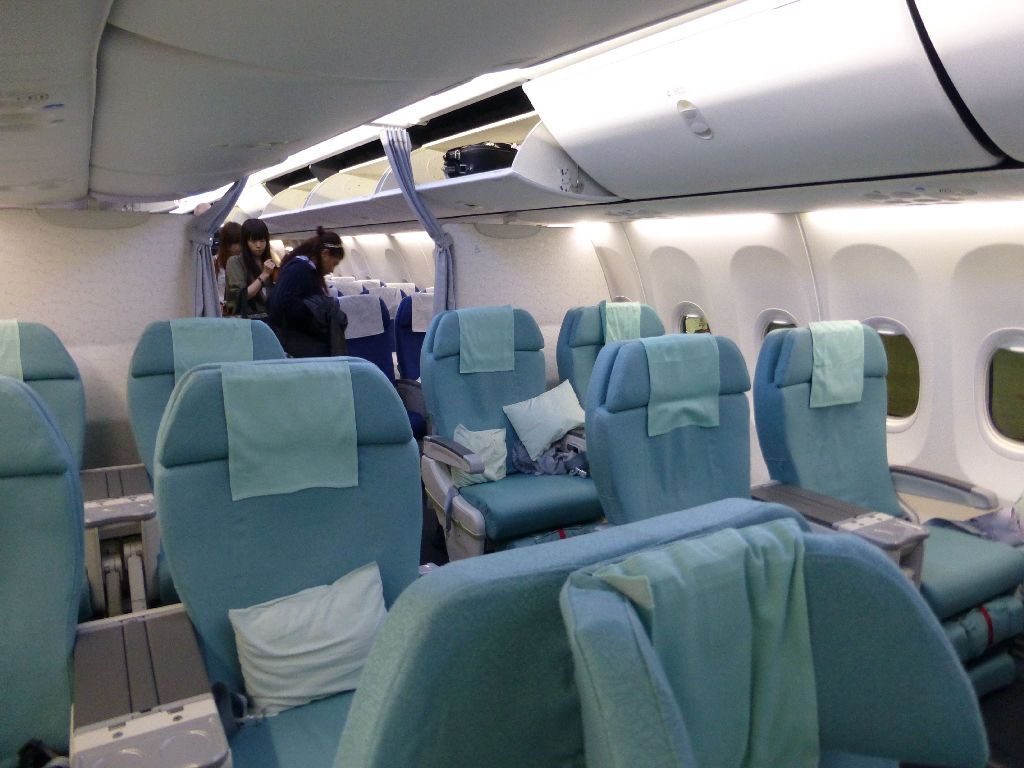
The J cabin starts at row 7 in the entire KE fleet, and cabin Y at row 28. I was not used to this convention and was called back by a FA even before I had realized that my seat 7A was on the first row. This is the space you have at that first row. I was sorry to hide the face of the Korean lady at seat 7A that I found very elegant, especially with the natural backlighting.
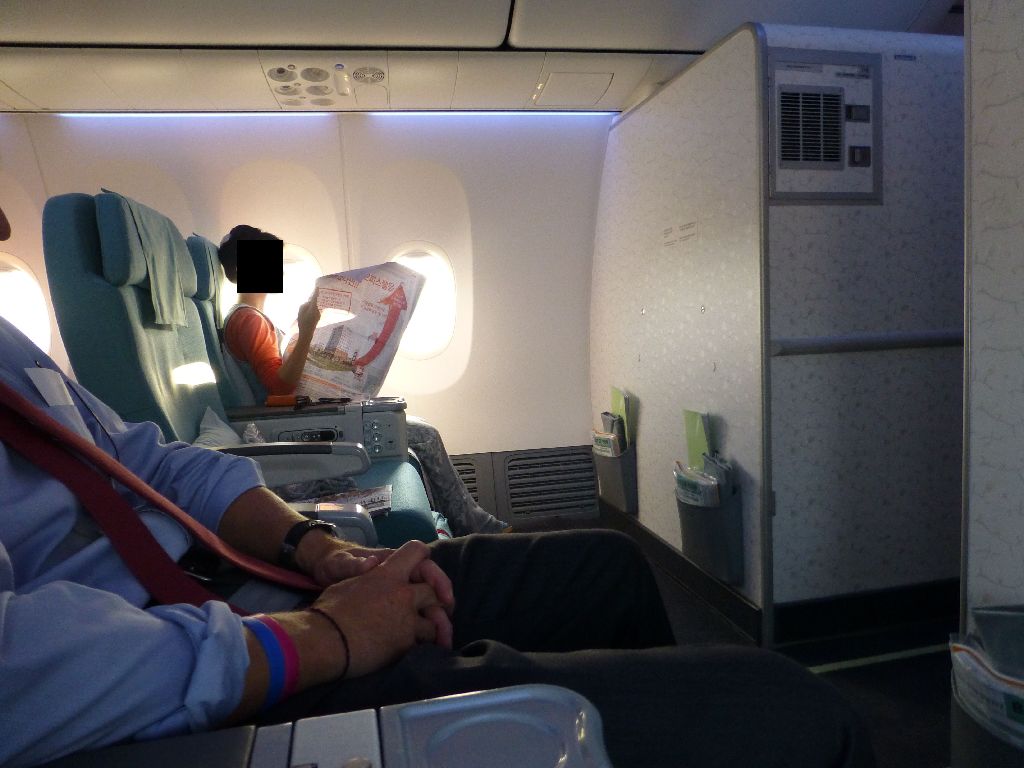
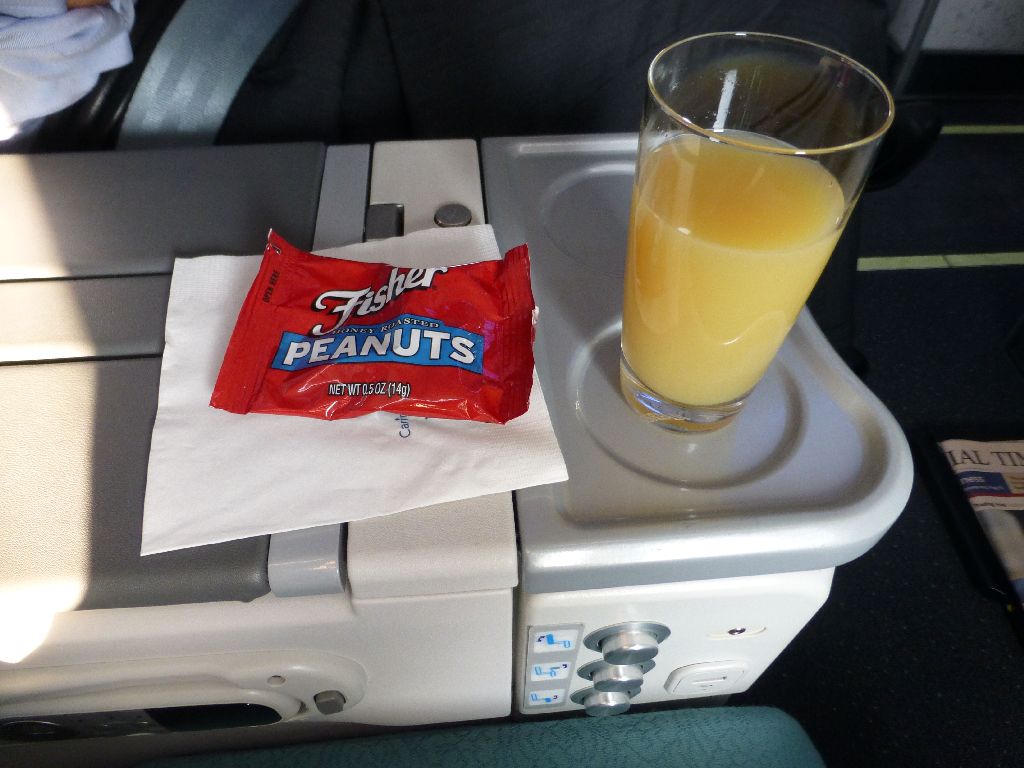
The safety demonstration is on the IFE, in Korean with Chinese subtitles. That reminds me of a debate on a French language forum, where some seemed to consider that airlines where there is no English language version of that demonstration are dangerous, assuming apparently that it is dangerous to board an aircraft when you do not understand English or the language of the origin and destination countries. How could the groups of Japanese manage when they travel in Europe ?
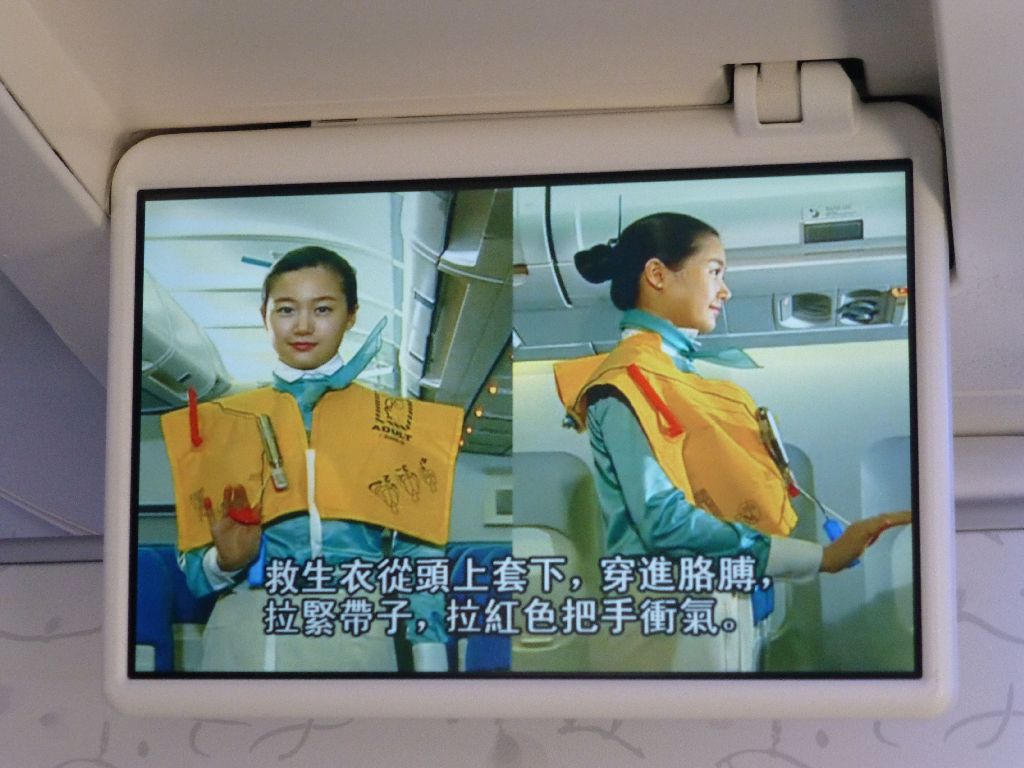
They probably read the safety information card which is here is in three languages. It confirmed that contrary to what satguru.com claimed at that time, KE has still 738s in its fleet.
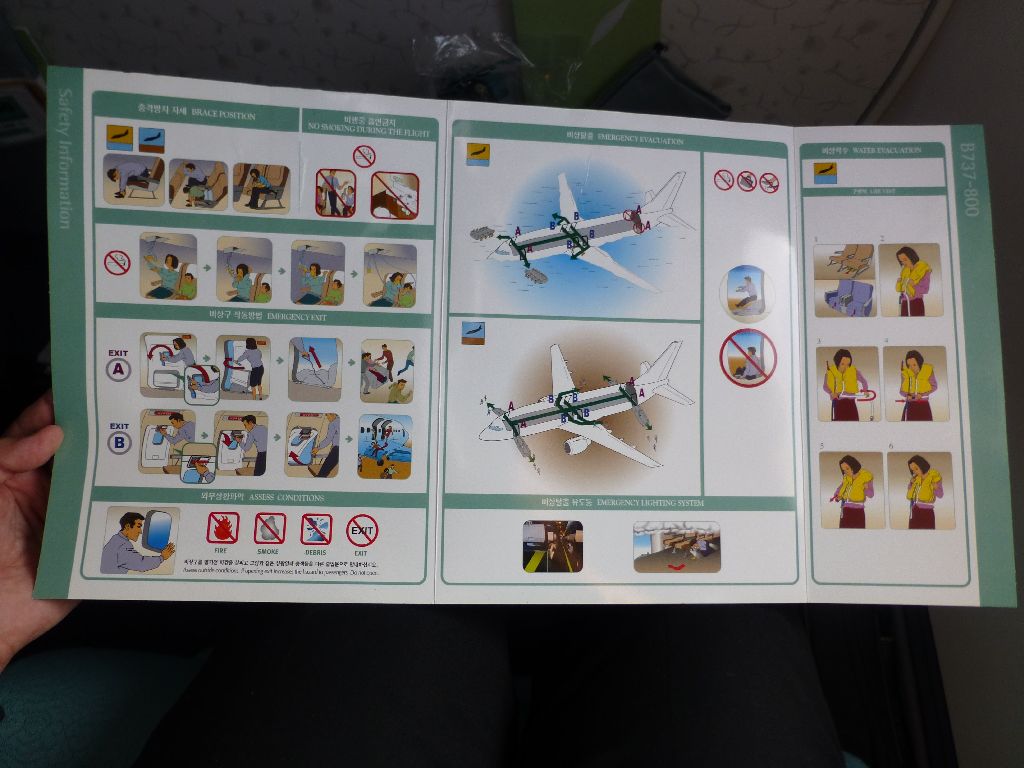
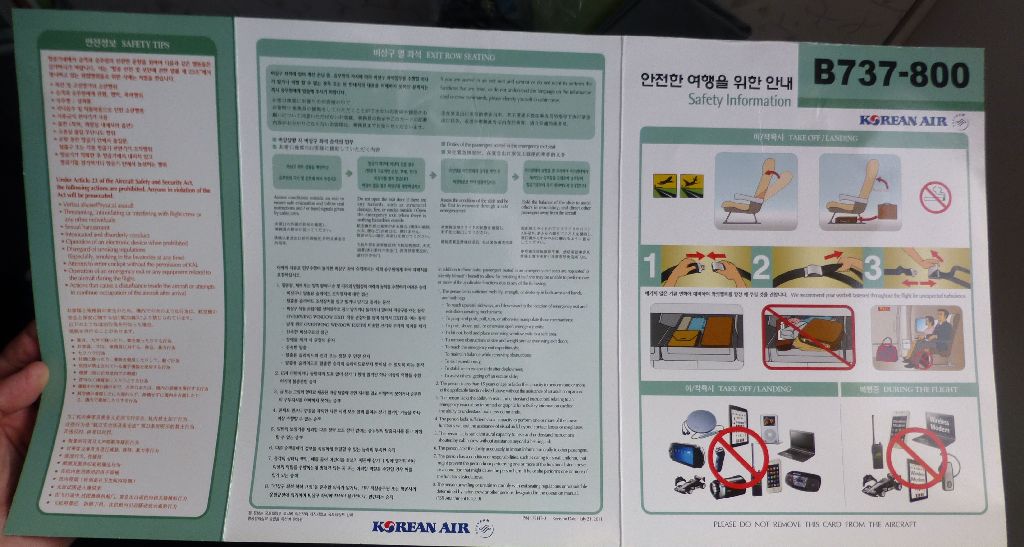
The menu which is applicable to flights between ICN and TPE is in the seat pocket together with the in flight magazines – this aircraft is apparently dedicated to this route. There is a different menu on the ways in and out, respectively.
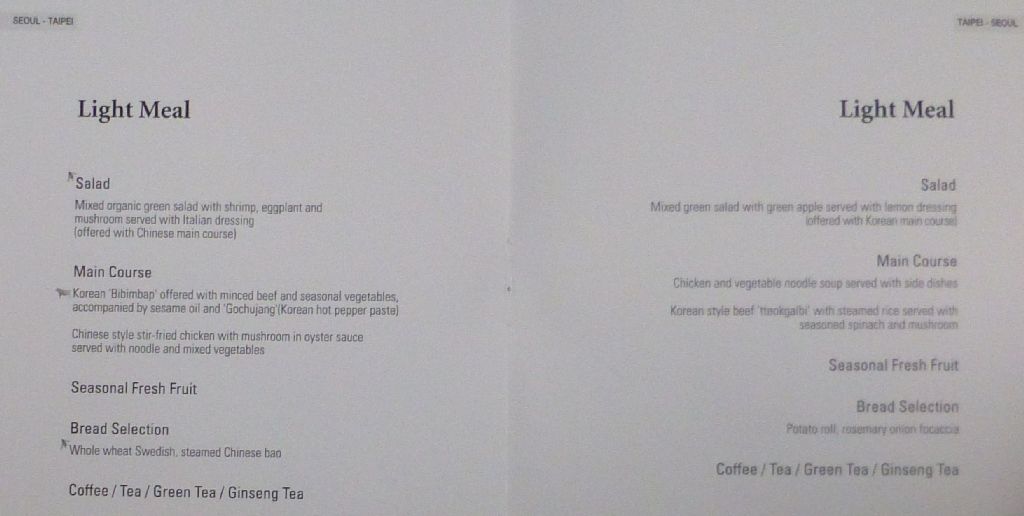

The neighbor, at gate thirty something is a 739ER, of which there only a hundred or so in the world. Bad luck, I travel in an extremely ordinary 738.
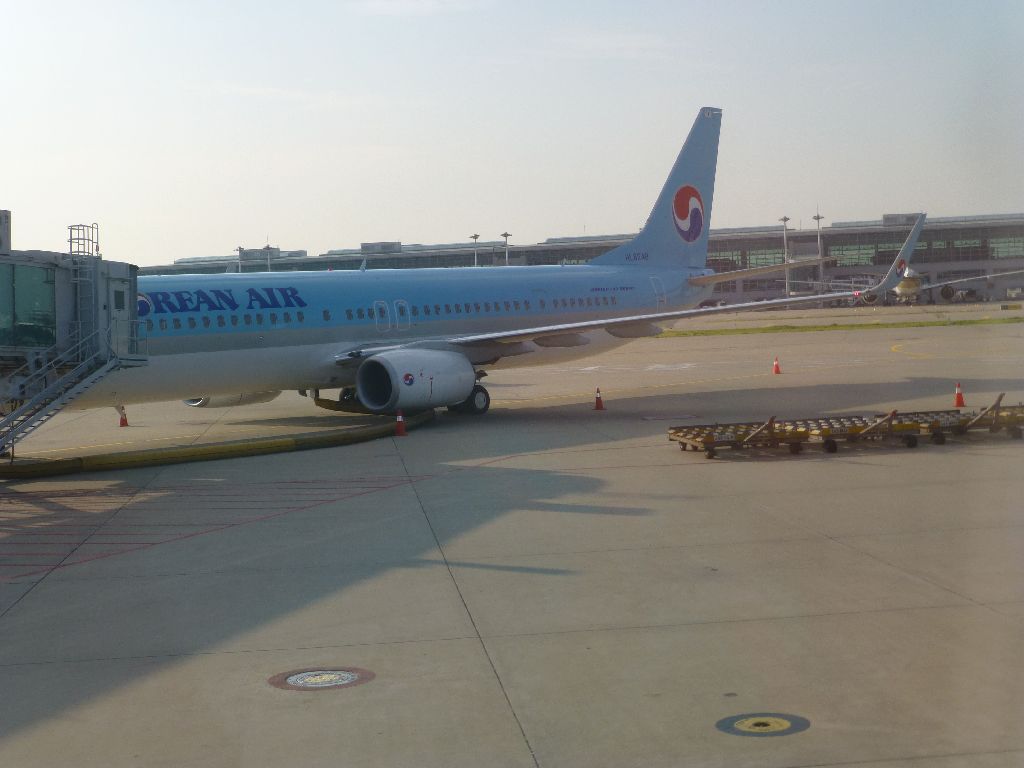
My company's travel agency had warned me about that. I have little flexibility to choose an exotic routing using rare aircraft when it is a business trip.

The advantage of going around the satellite terminal is to see non Korean planes. With in the order of appearance C-GHLK, an AC B767 AC,
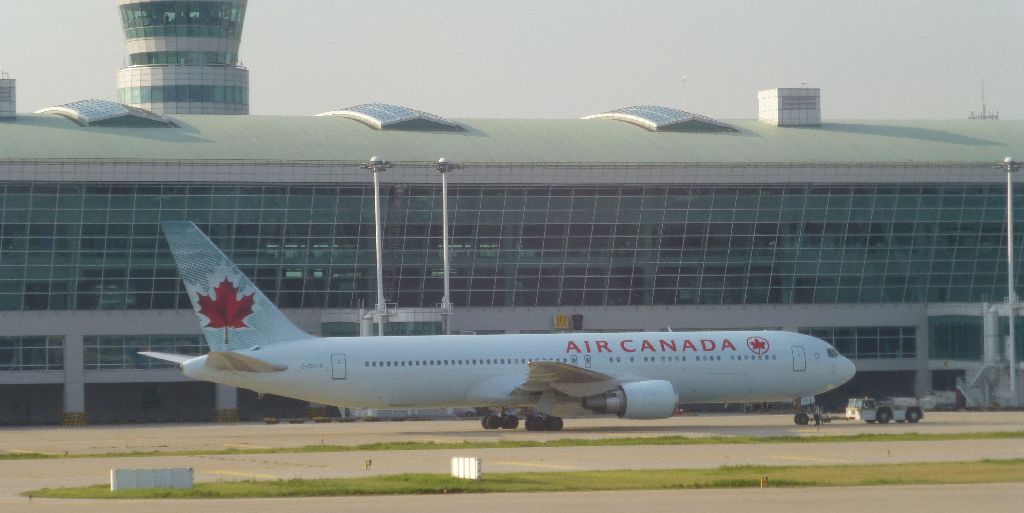
A7-BBG, a QR B777,
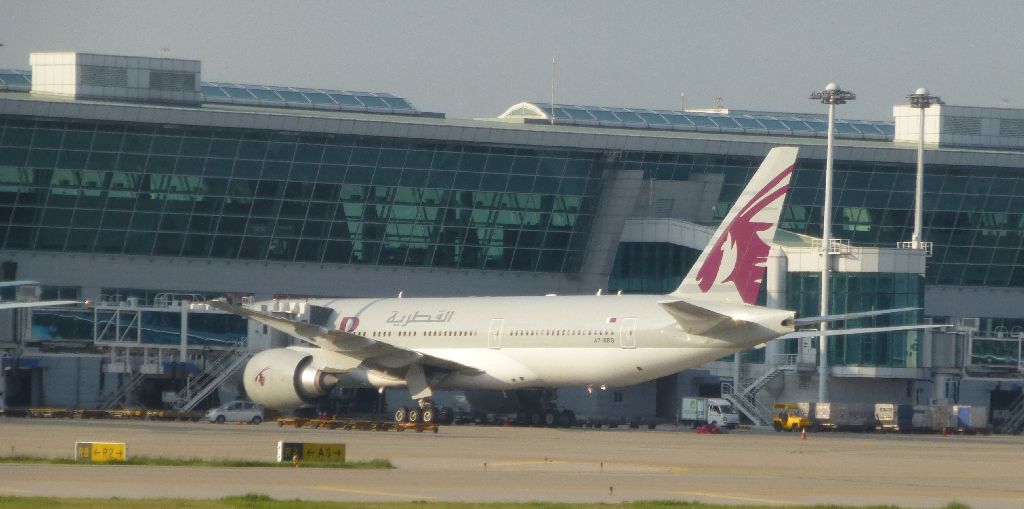
TC-JII, a TK A343,
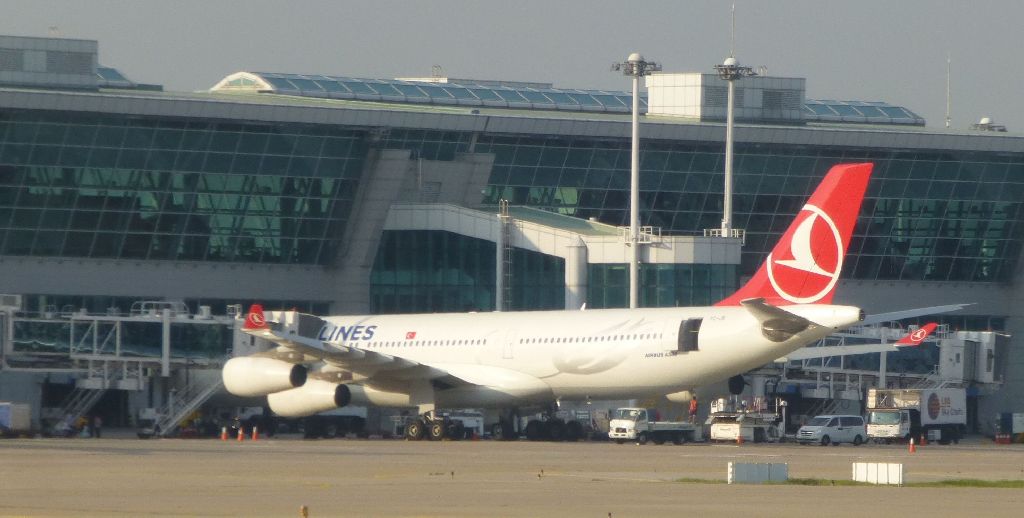
N861-DA, a DL B772ER,

B-6305, a CZ A321,
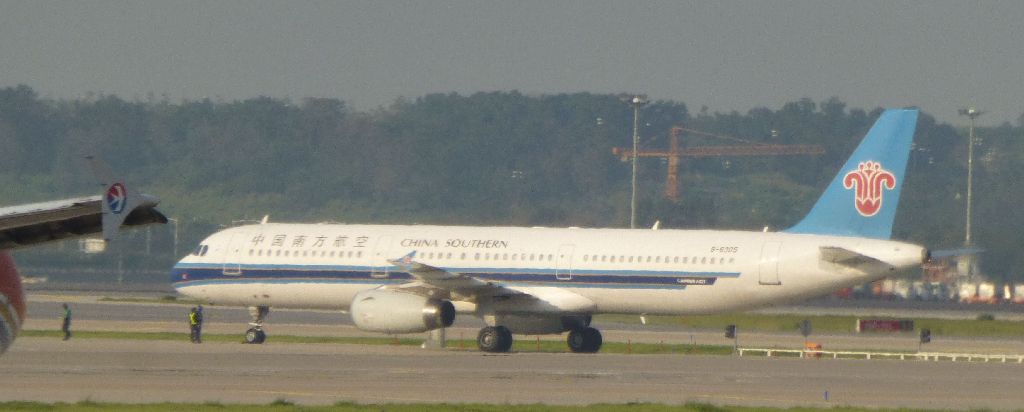
Et B-6016, an MU A320.
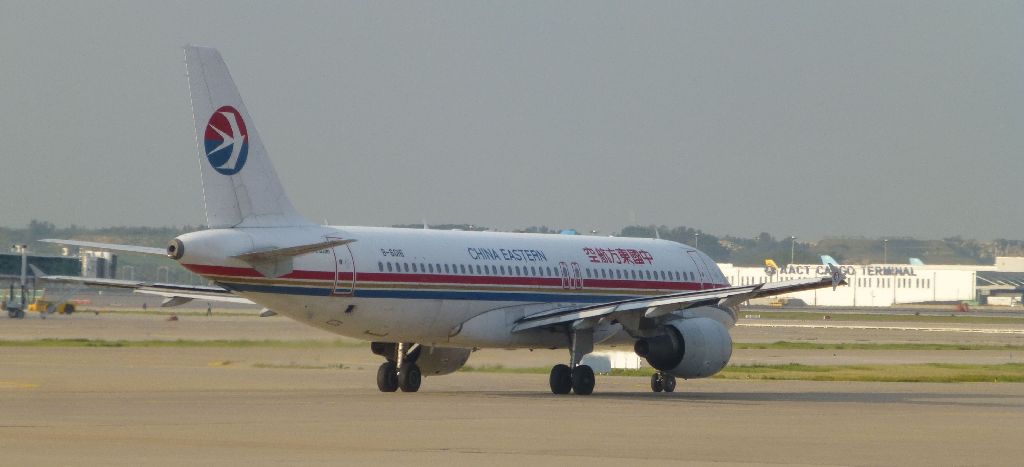
But we very soon fall back to the local light blue with two KE A332s in front of each other:
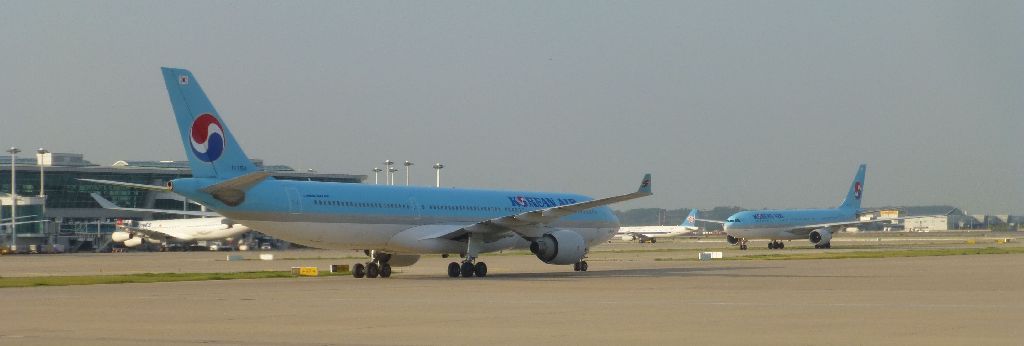
HL7715, a B772, leaves the terminal and will take taxi in front of us.

Two details of the KE livery. Korea seems to have an extensive notion of the duration of a year (2010-2012, Visit Korea Year)


Let us have a change while staying local with HL7756, an OZ B772ER
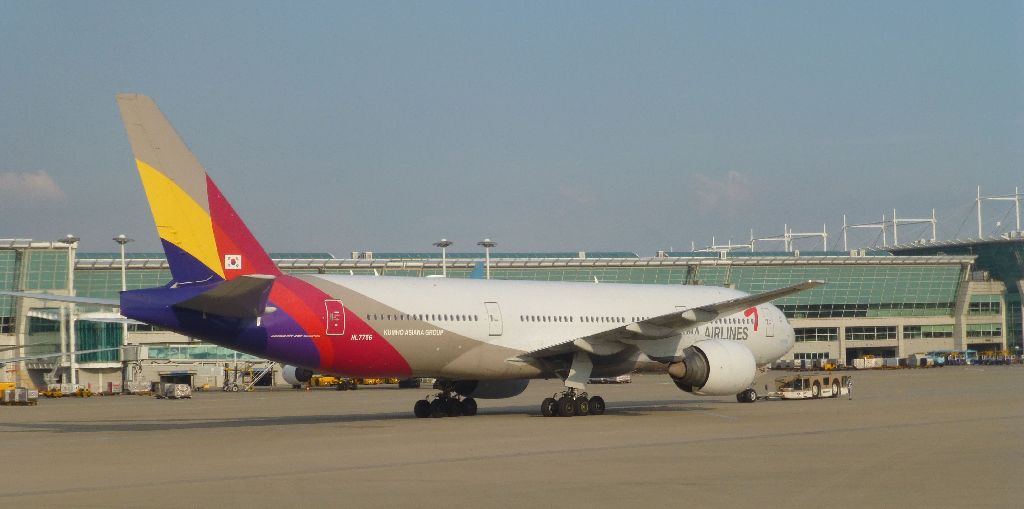
Pushback of another OZ (I am not sure about the type, but I assume it was assembled in Everett)

Asiana Airlines again with a cargo 747
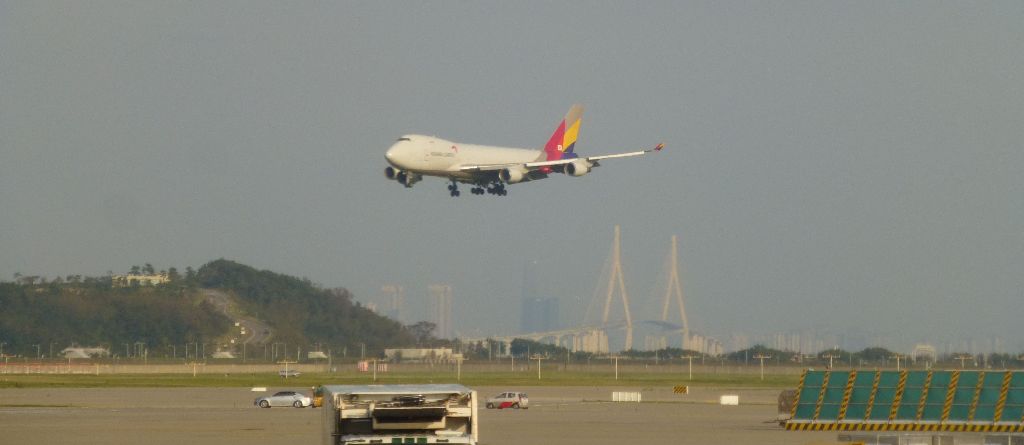
We are fourth to take off, behind the MU A320 MU, the CZA321 CZ and the KE B772 mentioned before
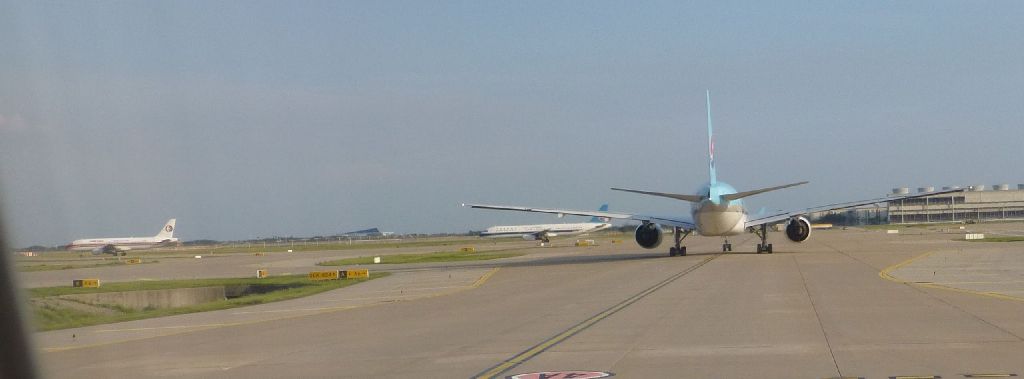
Our plane must look a lot like this other KE 738,
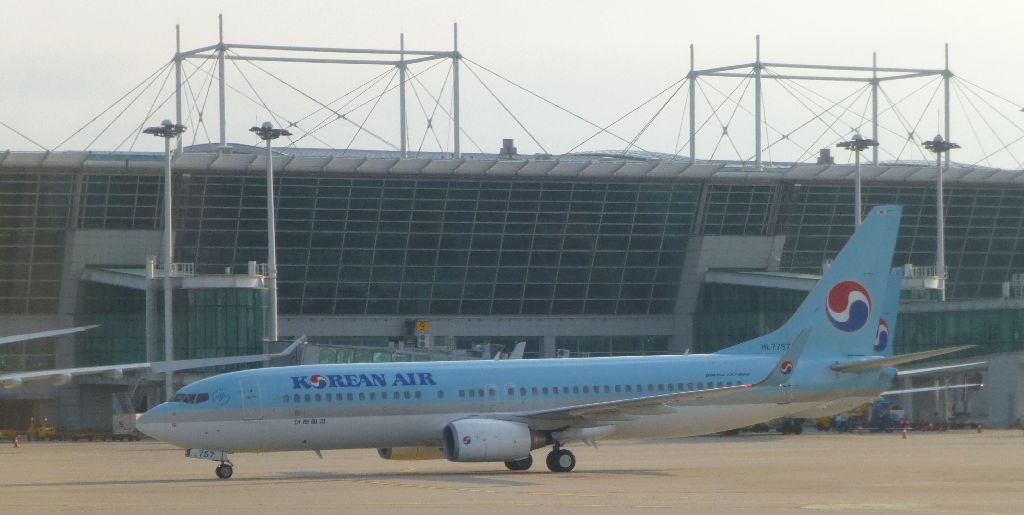
Takeoff. I do not promise a picture of the plane's shadow on the ground in each of my FRs.
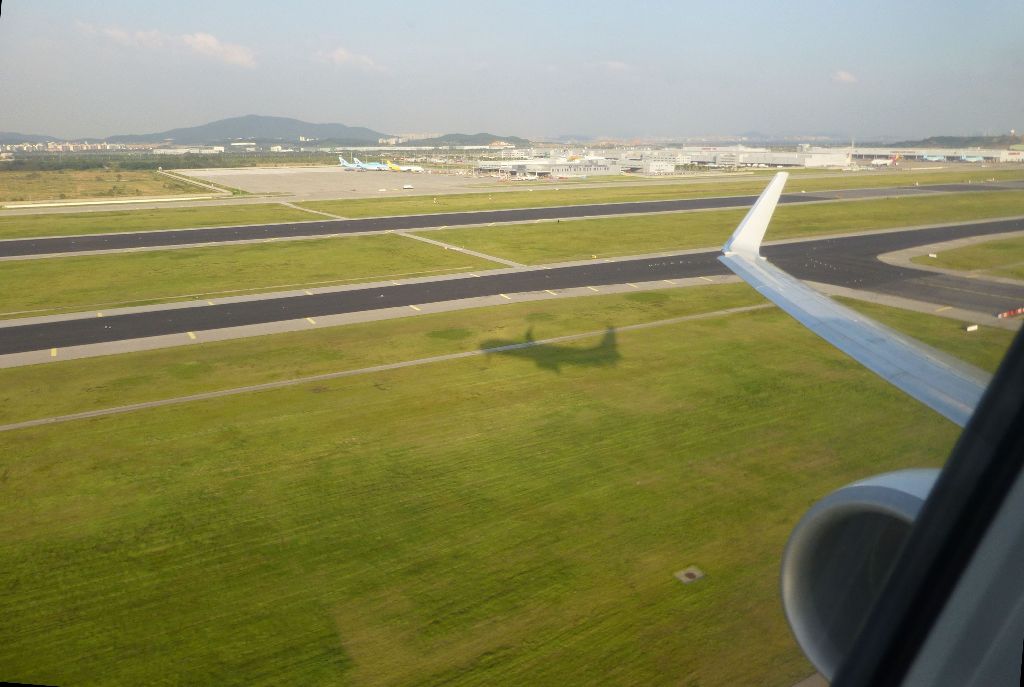


A strangely very remote parking area
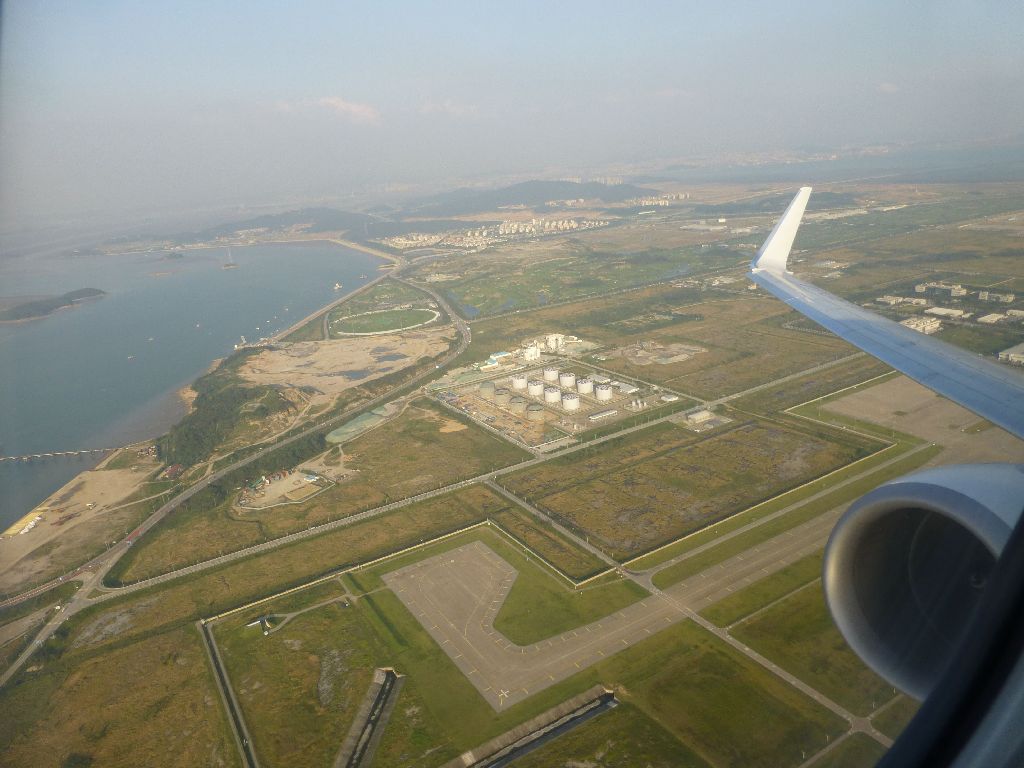
The islands near the coast, with and without a wing view.


This is the best reactor shot I managed to take through the window behind my seat 7E, while the passenger at seat 8E was taking a picture through the window behind her own seat (did you follow me?).
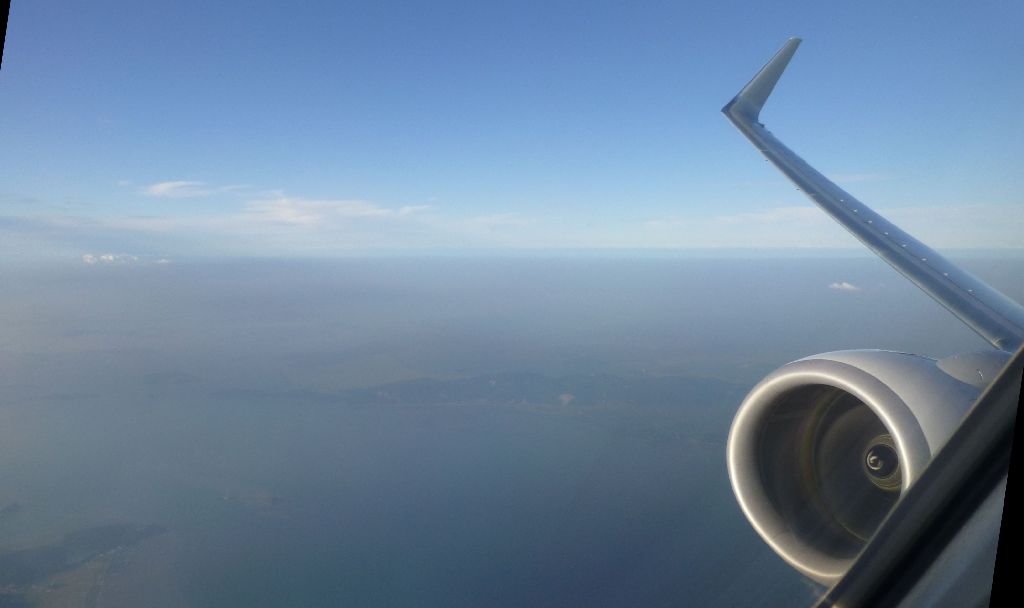
I did not regret the left side window that much, because the flight was nearly entirely above a cloud cover.
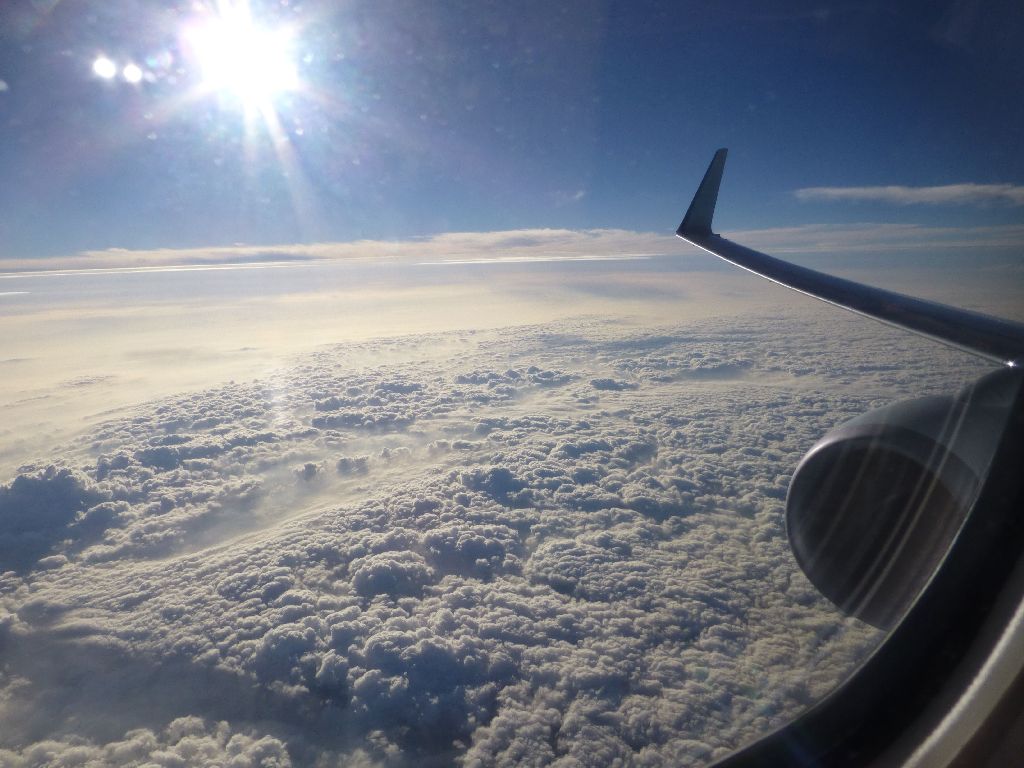
Massive image processing to save a massively poorly lit image of KUV (Gunsan), a mixed civilian/military airport. The quality of the image on Google Earth is such that you can count the golf carts of the neighboring golf course: so much for taking pictures yourself.


Since I liked on the way in, I took bibimpap again. It may not be high level gastronomy, but it is fare remote from instant noodles. The meal comes with a spoon and standard Korean metal chopsticks.

Again a combination of fruit and laptop flight report draft. The coffee is OK, but not very exciting.
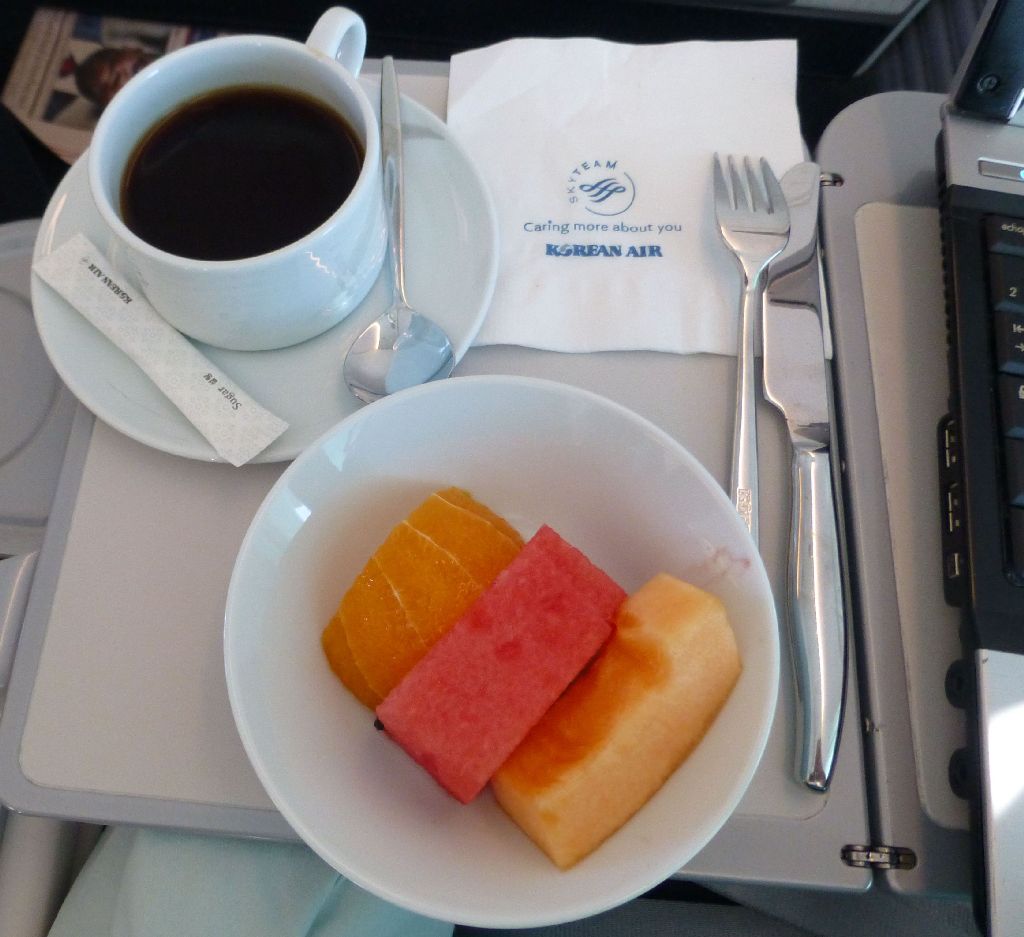
The sky darkened progressively




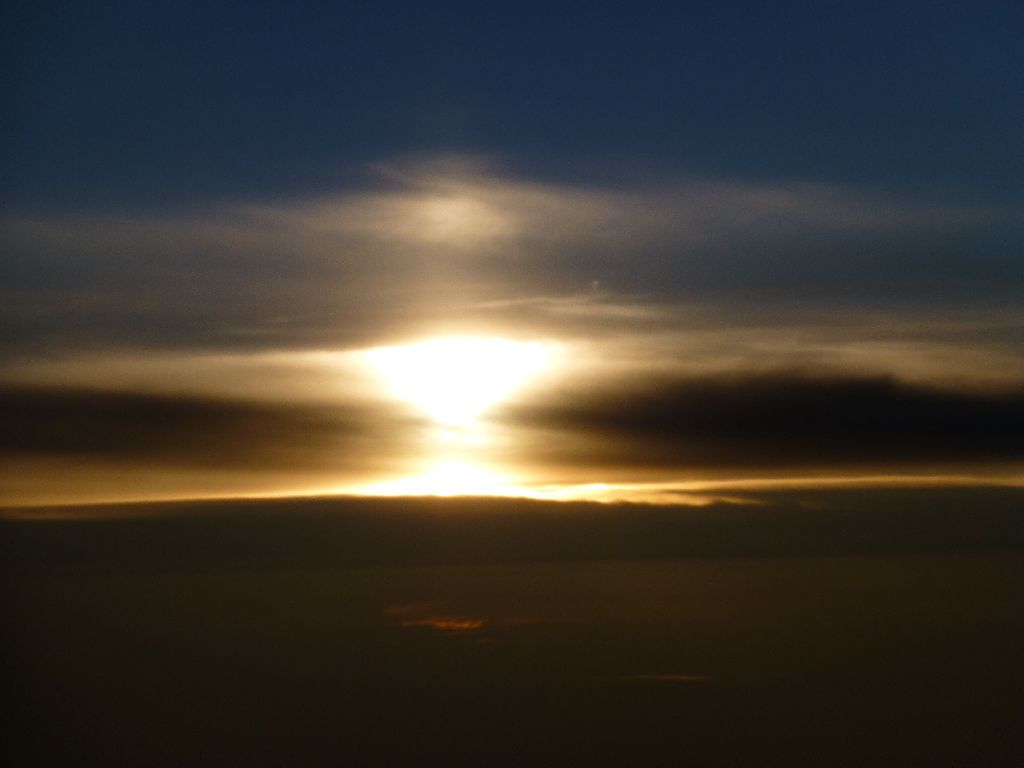
At the beginning of the descent, this FA helped a passenger place a hand luggage in the overhead bins, in a mood lighting in the KE corporate color theme.
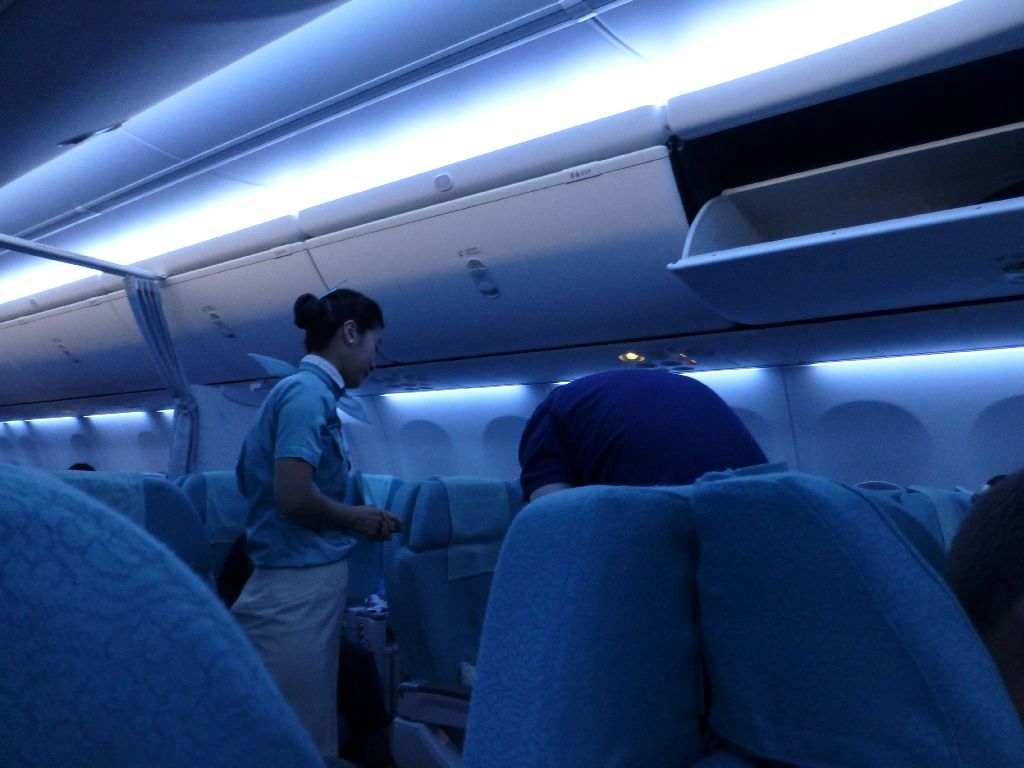
What about the winglet shot? It was somewhat late to think about it, but there it is. It did not have any decoration, not even blue color.

I won't show you pictures of Taoyuan by night. It is not very exciting in the daytime, and even less so by night when you camera is not sensitive enough.
Kiss landing in TPE, passing by the giant Taiwanese flag behind the right wing of a CI 744.
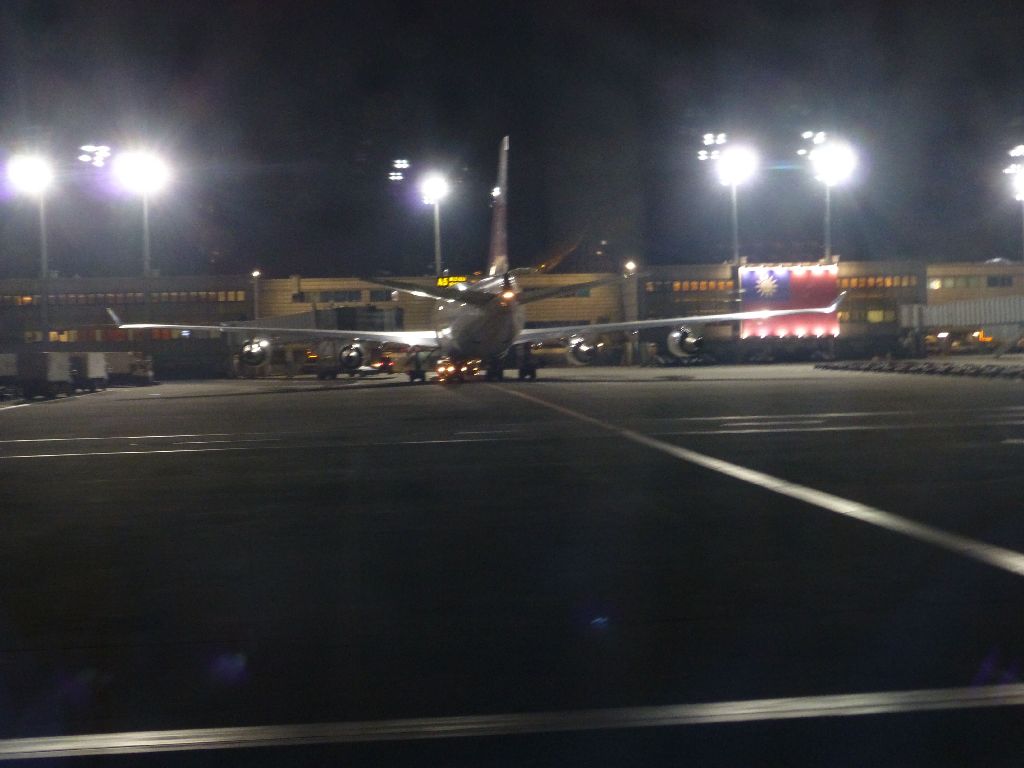
Bad luck: our gate was A2, the most remote one and one whose layout is such that any plane spotting is impossible after leaving the plane.
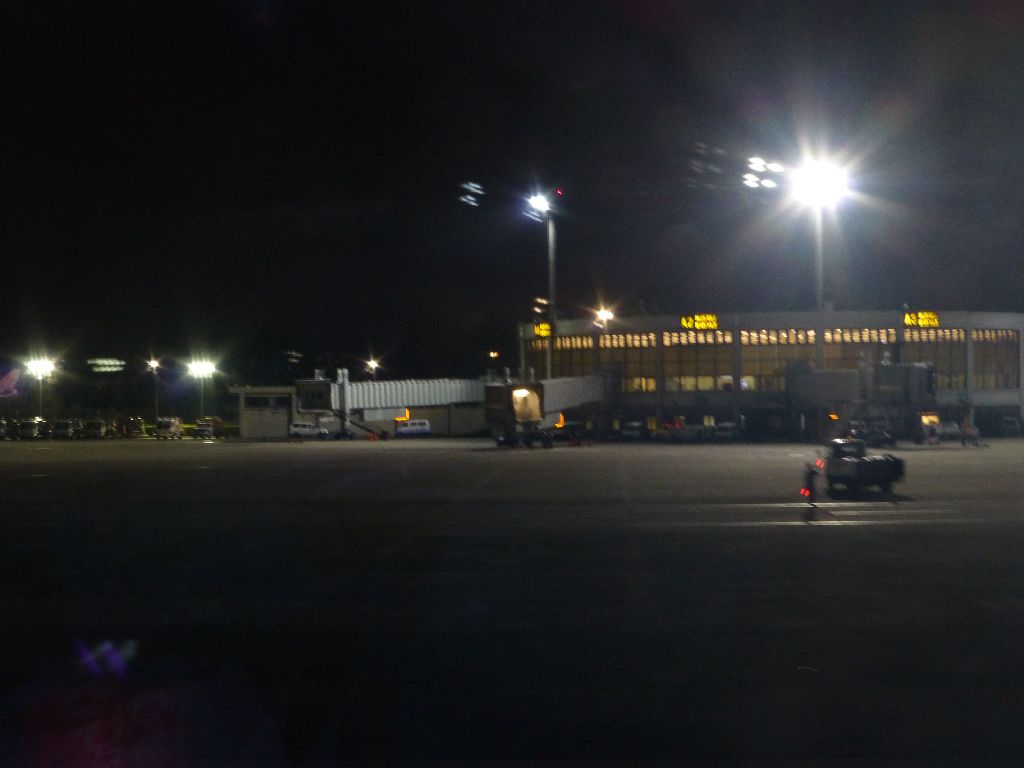
Better take my time before leaving my seat and take a picture of the CI 744

And the arrival of this Jetstar Airways (a.k.a. 3K) A320, arriving from KIX and bound for SIN.

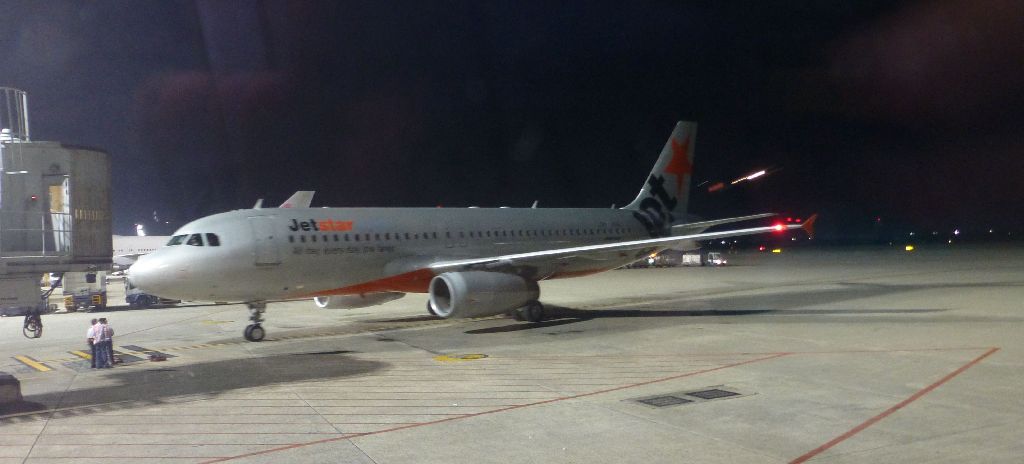
From Gate A2, it is a 400m walk (with the help of travelators for those who are tired) to the immigration
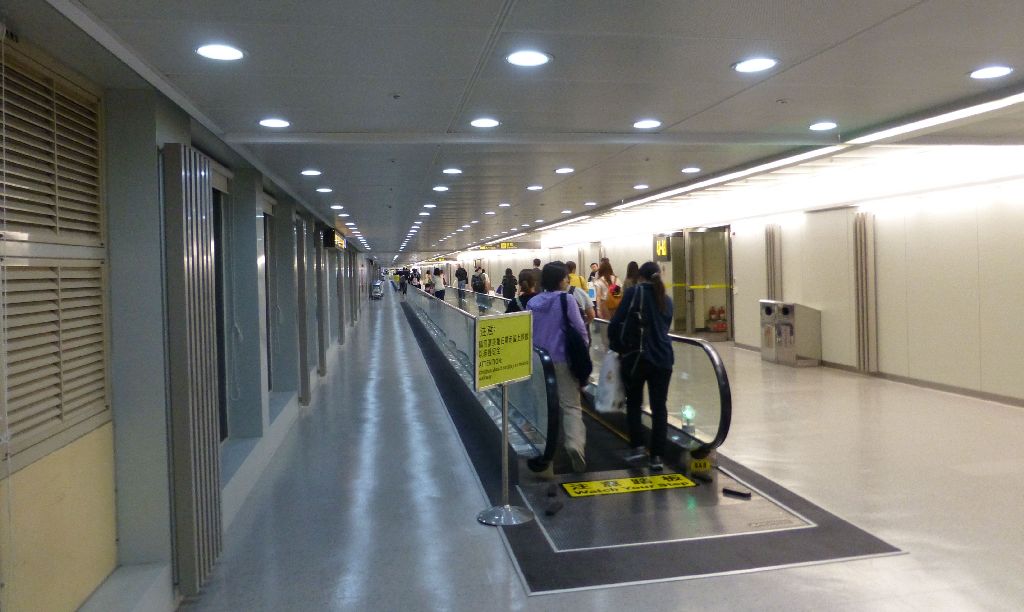
… passing by the duty free shops as usual, and also by the bags of wares bought on board and waiting for their owners.

Who could protest against such peaceful messages? Maybe the Chinese, because you would never see this kind of advertising on the other side of the Strait. In all fairness, religious propaganda is quite unusual in airports anywhere in the world, actually.
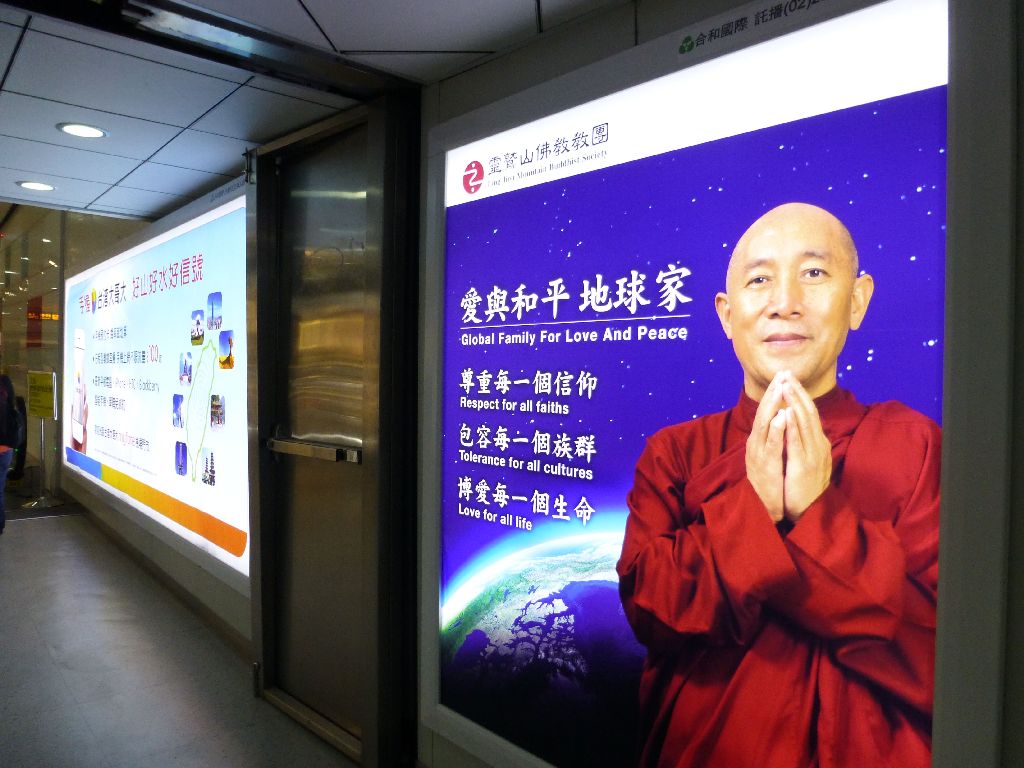
Last turn for the passengers before the immigration

Two counters for foreigner residents; the young policewoman had more suitors than her male counterpart, with two persons in her waiting line versus a single one for the latter. The policeman was equally friendly: a welcoming smile when I gave him my passport and resident's card, a nod meaning that everything seemed OK and a big smile when he gave me back my documents. The impact on the image of a country of the behavior of its immigration police – the first and last official contact of a foreign visitor – should never be underestimated. I wish some countries got this message across.

I did not have much time for looking for my flight in this display, because my suitcase came out among the first priority ones, at 18:50, which means 15 minutes after the scheduled time of arrival of the aircraft.

Now, I only need to go landside

If you believe that a FR ends when the passenger is landside, you can go directly to the conclusion, since what follows is a tourist bonus.
This bonus begins by walking straight to the travelator going down to the lower level where the bus station is. The new facilities may look more modern, but there were zero seats for waiting for a passenger, contrary to the corresponding bus station in Terminal 2. Actually, you can see some (very few) in the background behind the travelators, and more important, this was a temporary situation : there was going to be a lot more seats, close to the passengers exit, albeit less comfortable than in Terminal 2.

The bus line for the main station Kuo-Kuang's Line 1819. This time, they use a bus fitted for long distance trips: this is akin to having a plane for long haul routes on a short domestic flight.
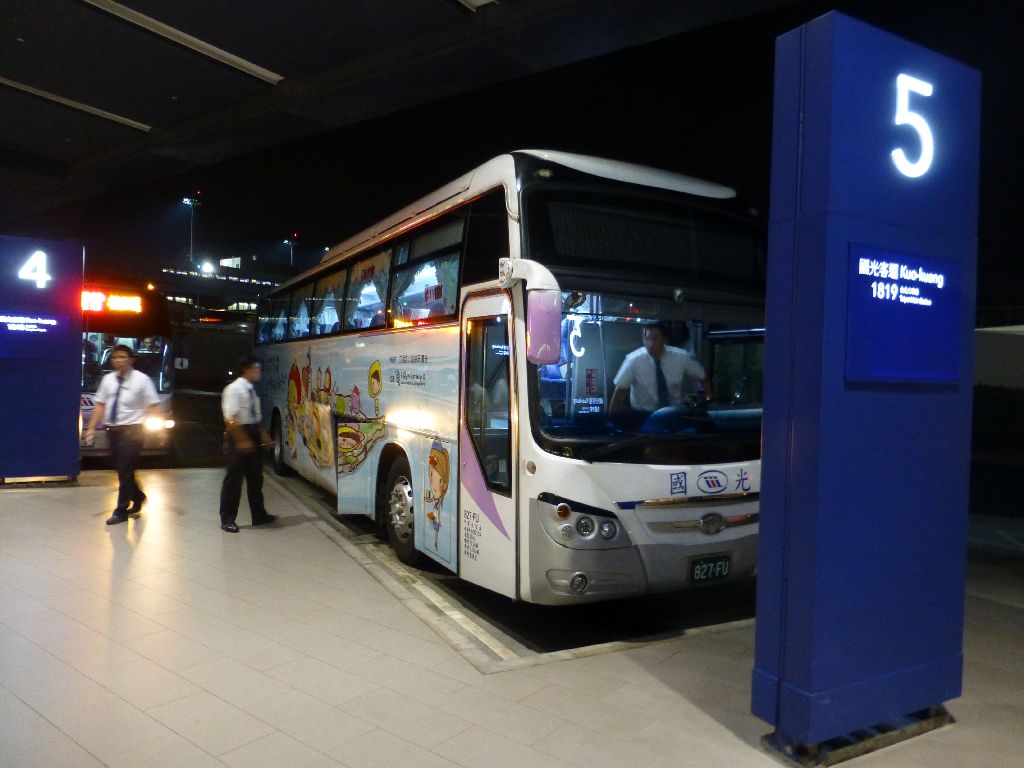
The decoration is very kitsch, with embroidered headrests and purely decorative drapes. But note that the seating has a comfortable 2+1 seating layout.

And when looking from the back, you can discover the presence of an IFE at each seat, of reasonable size and quality.
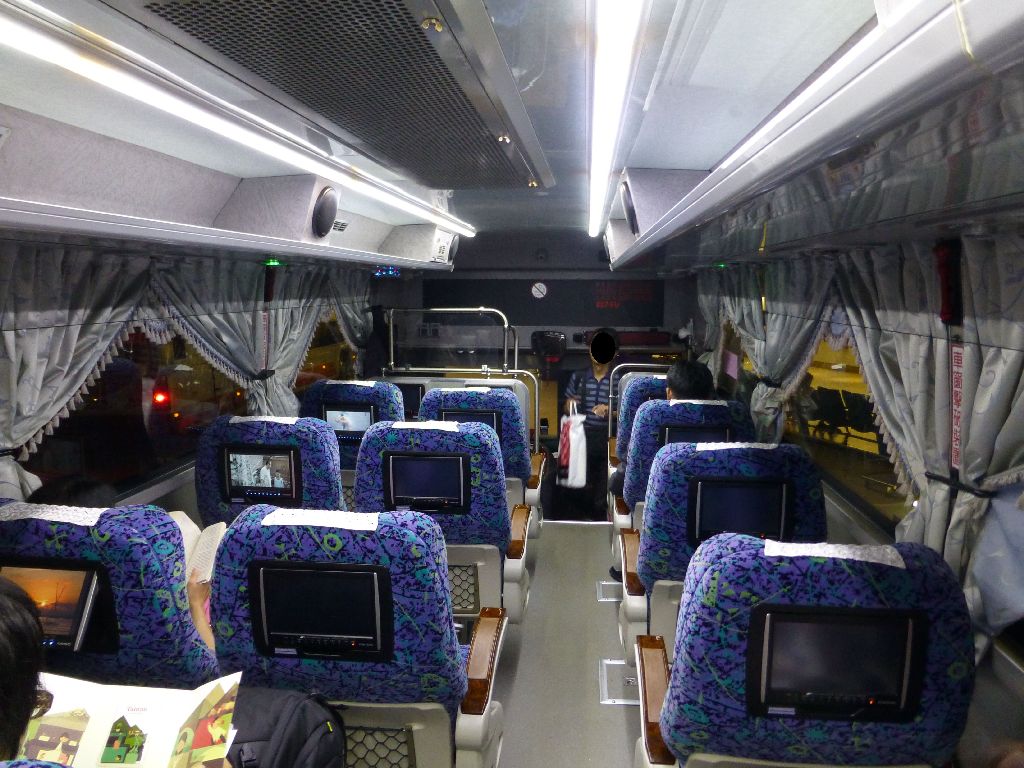
The seat pitch is comfortable too
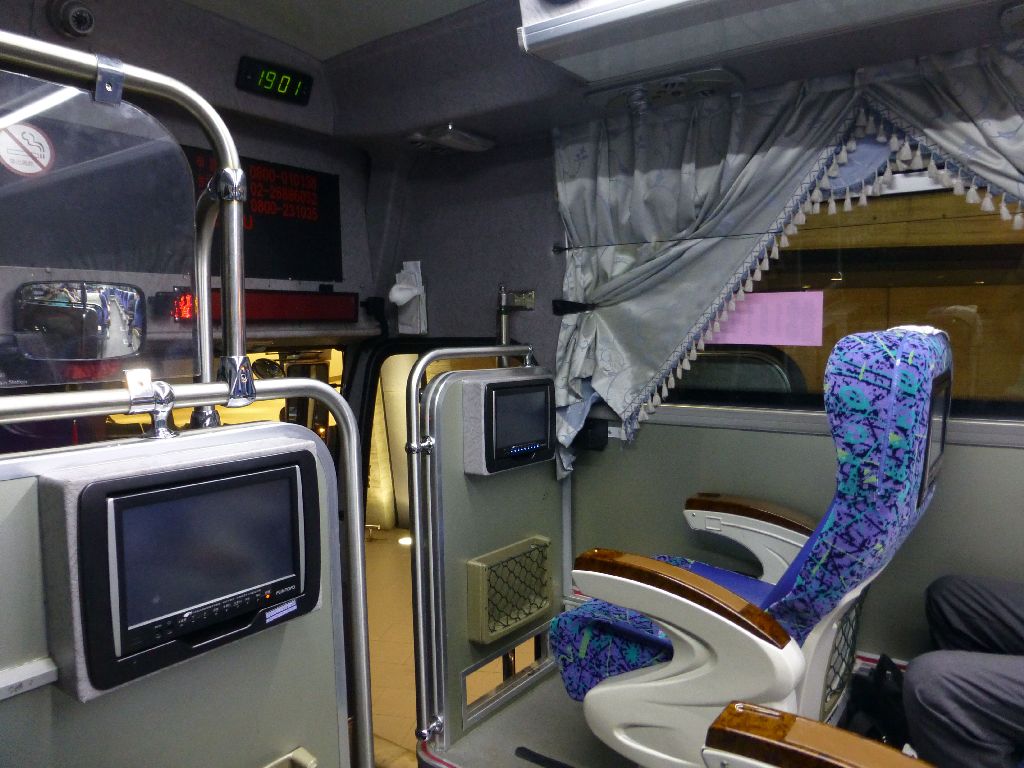
The offering of the IFE is far from being ridiculous. In order to adjust myself back to the local environment, I selected a continuous news channel, which inevitably opens at 7pm on the 9/11 commemorations. The bus leaves the terminal at 19:01, 26 minutes after the scheduled time of arrival of the plane in TPE.
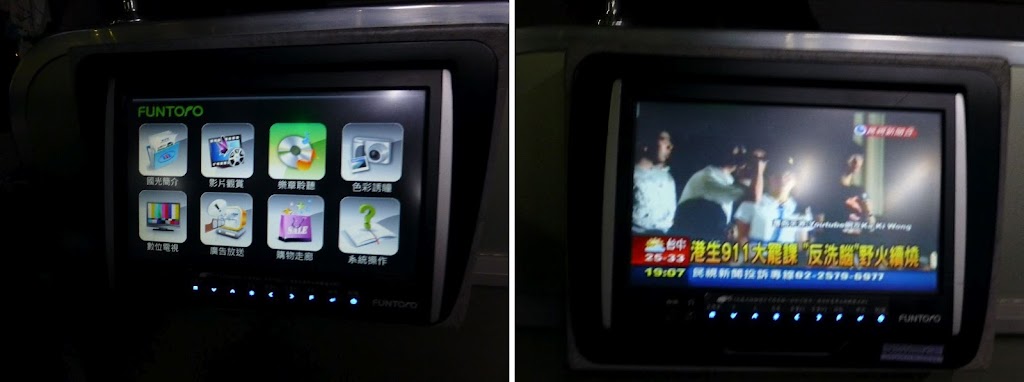
The next topic is a crisis of equal magnitude: the dramatic rise in the fixed price restaurants of the hot pot (火鍋) menu, due to the bad cabbage harvest (with the interview of a local producer) and the spectacular rise of the price of beef meat (I saw that too in my local supermarket).

A report on tourism in North Korea (by train from Beijing) ensues, then the weather forecast: it will be hot with 0 mm of rain and 35°C in Taipei.
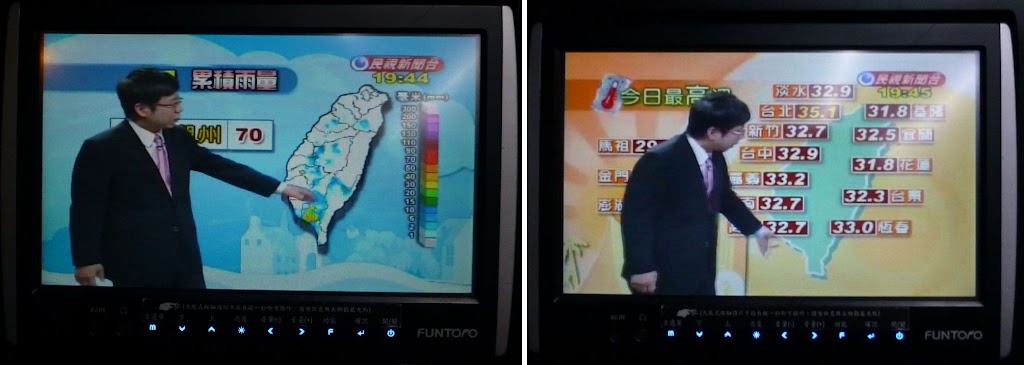
下一個, 台北車站 (Next station, Taipei Main station) : pronounced Xia yige, Taibei ce dzan with a strong Taiwanese accent, this is the announcement of the last station of the bus. What would a country be without its distinctive accent?
I only needed to turn around the corner of the avenue to reach an access to the subway, where there is always a wheelchair and luggage friendly access at the ticket control gates.

How can you tell a Chinese tourist on a Taiwanese escalator? He is usually the one who stays motionless on the left, going up or down. You never see any here, because they are usually bussed directly to their hotel.
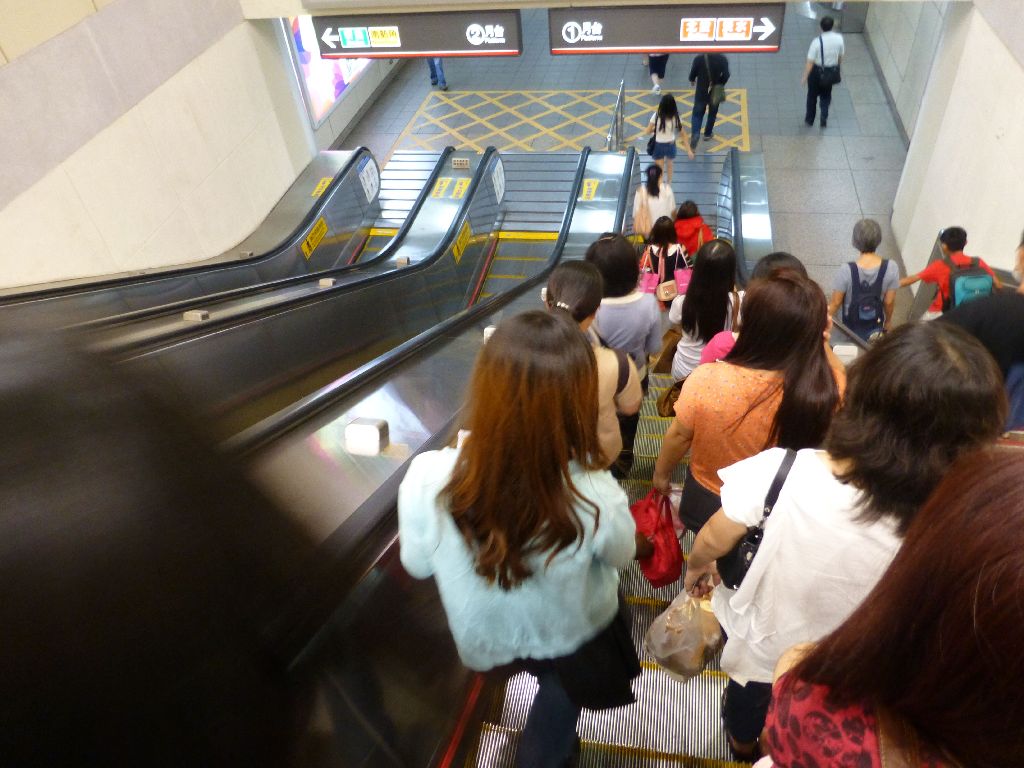
Two Taiwanese persons waiting anywhere spontaneously form a waiting line, no matter if there are marking underground…
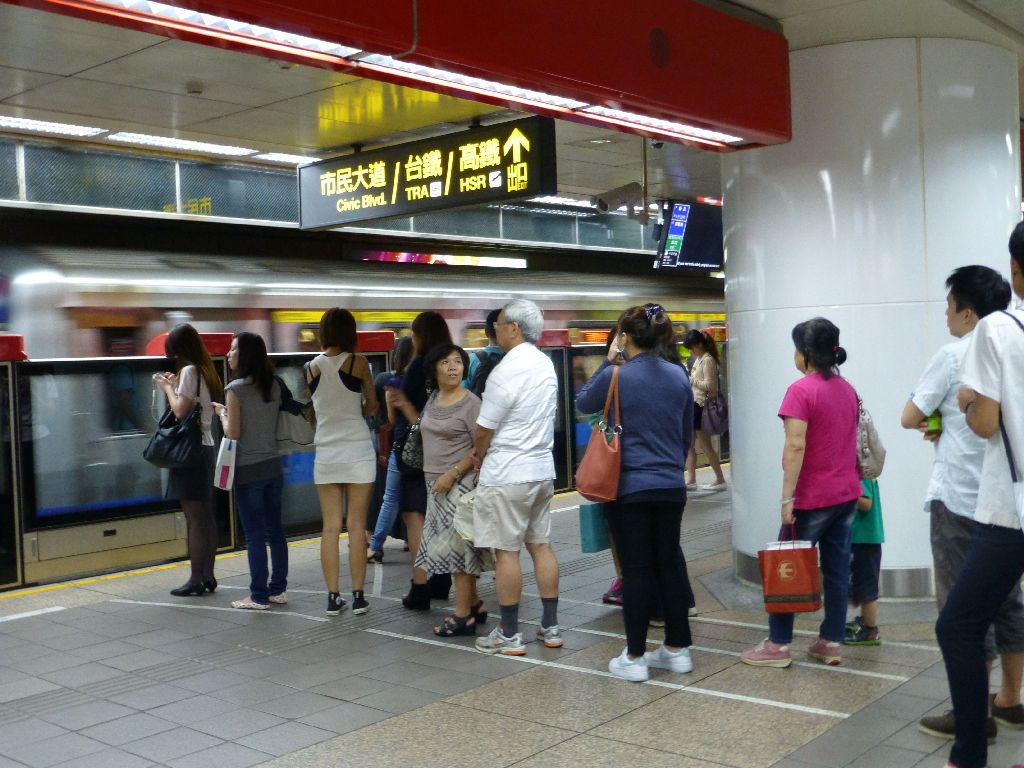
… or if there is none above ground at the suburban bus stop.

I could have taken the lift for handicapped passengers, which are present in each station. I mean both lifts and handicapped passengers; you see there is one in the lift, which reaches the end car, which has fewer seats to accommodate more wheelchairs (and bicycles during the week-end, too).
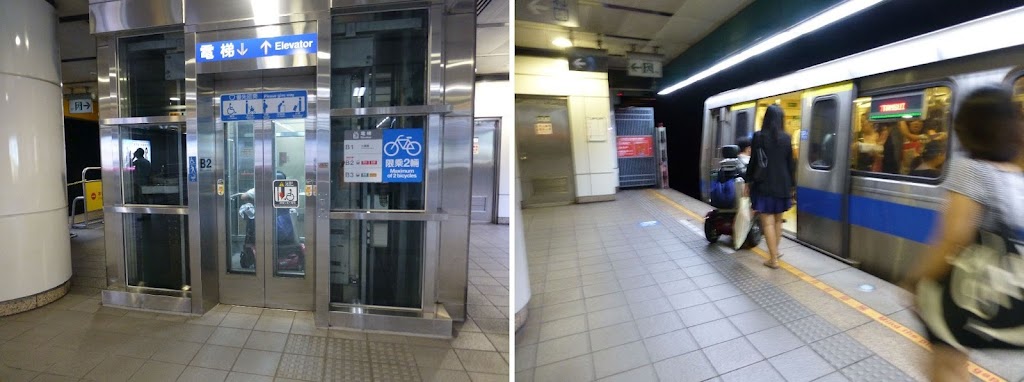
The Taiwanese always let the passengers leave the train before climbing themselves

It does make sense to let passengers leave the train first, especially when the passenger boarding the train is a wheel chair handicapped person too. This one wears a face mask, because you can be handicapped and wish to protect your skin from the sun, like all Taiwanese ladies do. Of course, there is not much sun underground, but it is easier to keep it on during the subway ride.
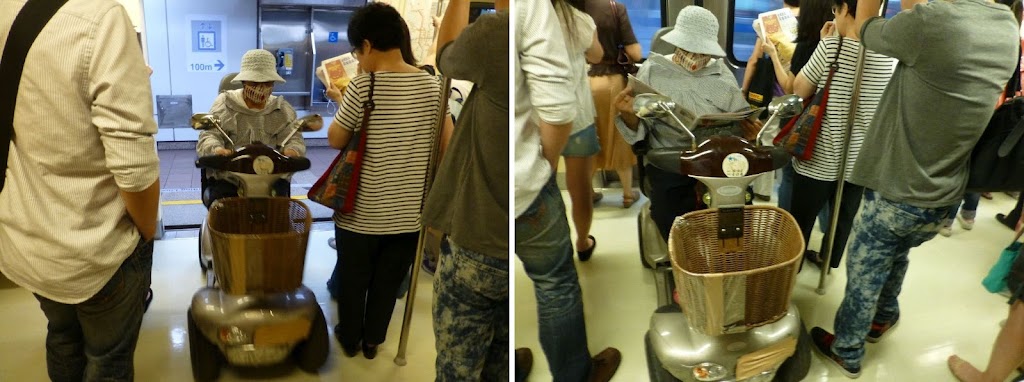
You can't imagine the density of the traffic of motorized wheelchairs in the Taipei subway. So much so that there are dedicated signs to ask them to slow down in order to avoid traffic accidents with pedestrians, like cars in the streets.
They don't risk running out of power, because there are signs reminding that they can ask help from a transit system staff to plug their charger into one of the numerous power outlets at floor level. They even provide both 110V and 220V power.
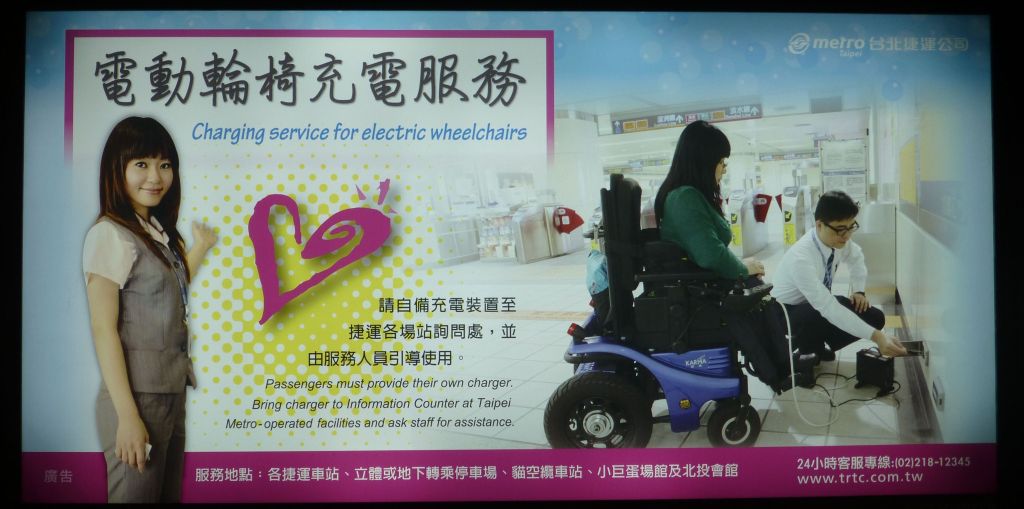
For non wheelchair bound passengers, there are also plugs to recharge your portable toy, and also free wifi coverage. These power plugs are few in between, because healthy travelers can walk to the next plug, unlike a handicapped person in a nearly discharged powered wheelchair.

Is the mass transit system of your favorite city up to Taiwanese wheelchair friendliness standards ?



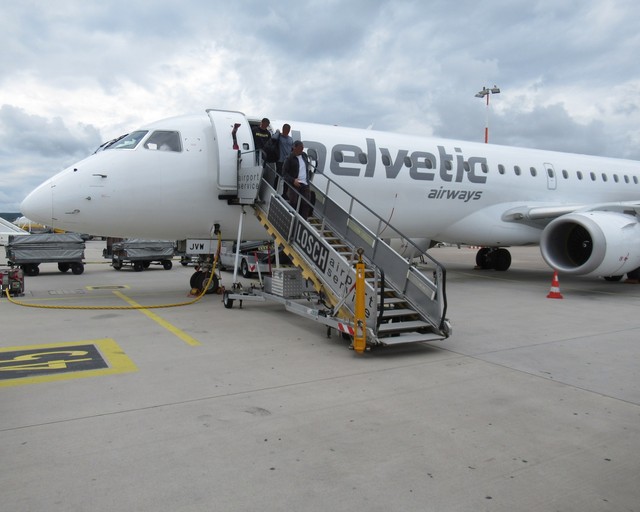

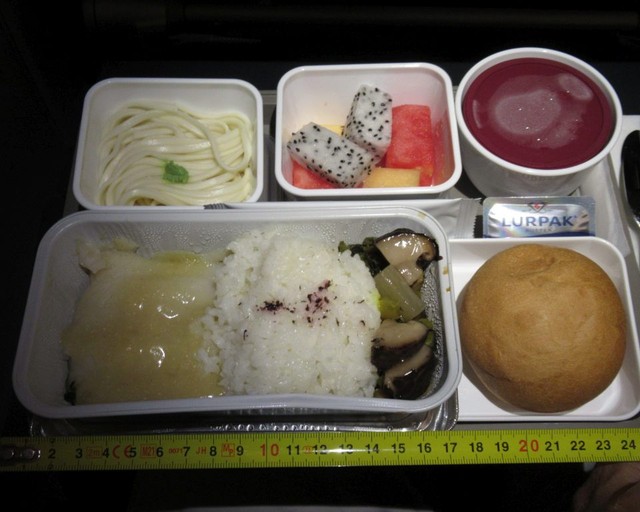

Thanks for this re-post in English. KoreanAir is to SkyTeam what SQ is to *A...the airline that thinks it is above the others (because it is, LOL) and that the rules don't apply. It is a shame that ST Elites/J pax don't receive the same perks on KE as on others. It seems rather basic to be able to chose seats ahead of time. Luckily you still got a window seat. Those of us AvGeeks who like window seats tend to get lucky since most business people prefer aisle seats in 2-2 configs. The lounge is very good and I really like the cabin of this 738 with the Boeing Sky Interior. It really does make it seem more spacious.